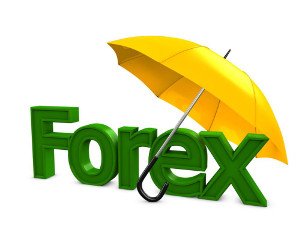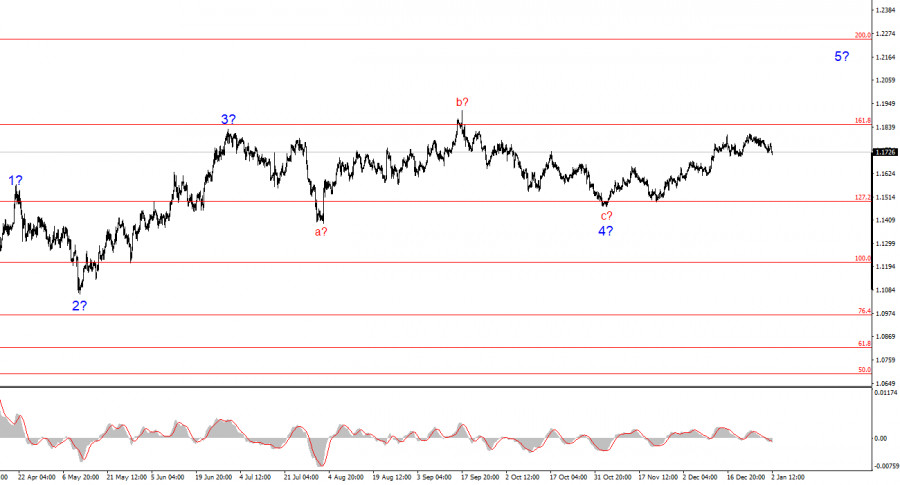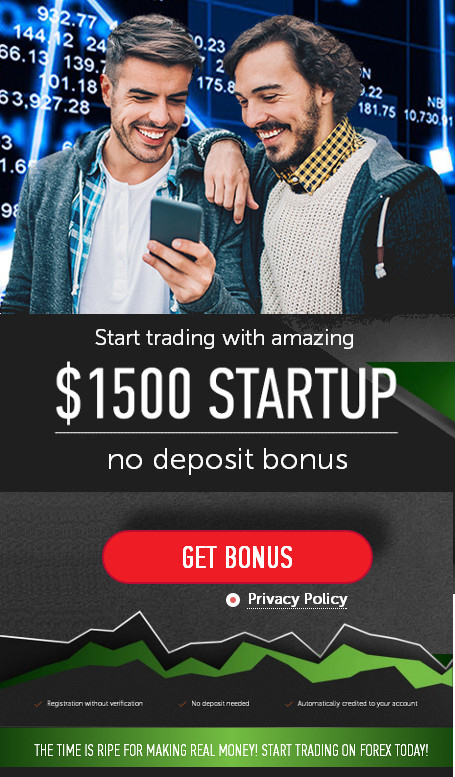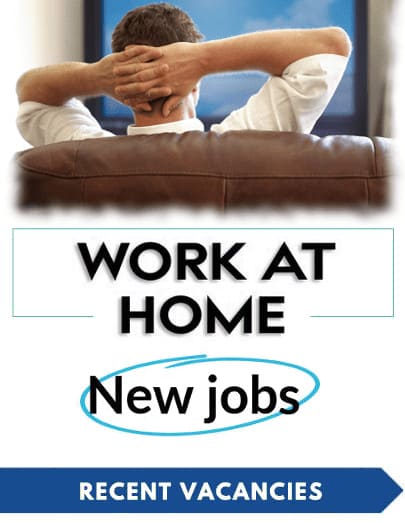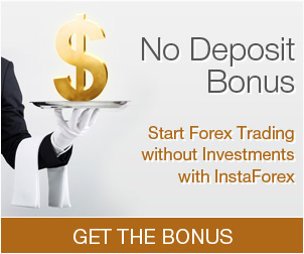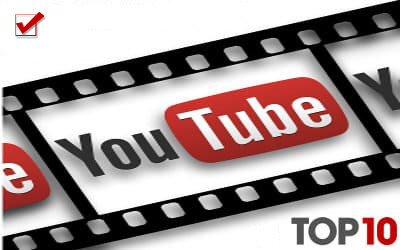Daily Forex market analysis - graphical, wave and technical analysis online
Daily Forex* Trade News, Forex market analysis and Economic News online. In this section you will find a fundamental and technical analysis of the Forex market for trading online and Economic News.
Follow the publications of our experts, and you will be able to objectively assess the situation not only on the international currency market Forex, but on all other world trading platforms. With the help of professional analysis of the foreign exchange market, you can invest your money.
Forex Analytics and Daily FX & Economic News • 05 January 2026

Our daily Forex news of the Currency Market is written by industry veterans with years in trading on market Forex. Read the daily analytics, forecasts, technical and fundamental analysis from experts of the Currency, Cryptocurrency and CFD Market online.
American dollar. Weekly preview
.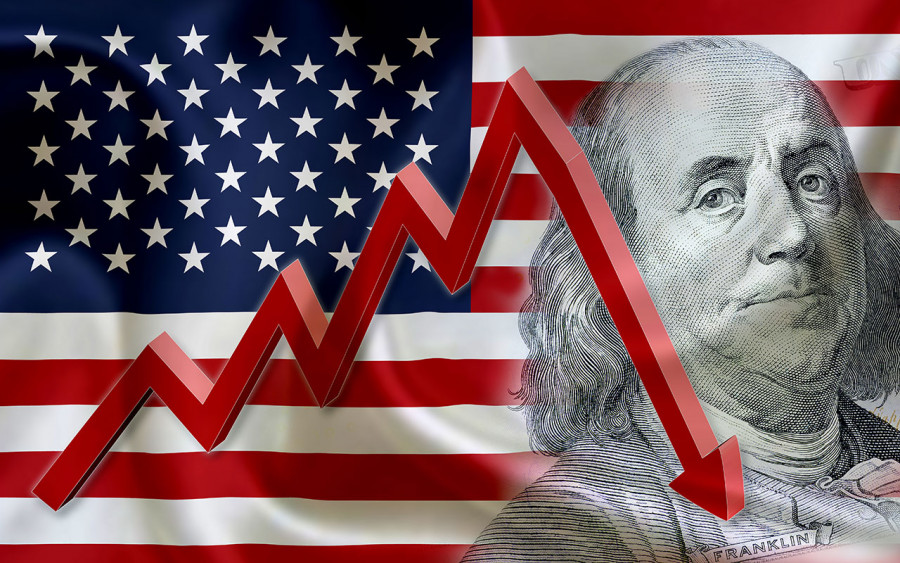
The American news backdrop next week will again determine the fate of the EUR/USD and GBP/USD instruments. Analysis should begin with Saturday's invasion of Venezuelan territory by U.S. military forces, which ended with the capture of the country's president, Nicolas Maduro. Maduro is currently held at one of the American military bases and will soon be transferred to the United States for trial. Therefore, Monday may open with a gap on the FX market, and then traders' attention will shift to the more familiar economic backdrop — namely, the American, not the European or British.
The first week of any month is when the market adjusts its expectations regarding Federal Reserve monetary policy. During this period, labor market and unemployment statistics are released, which allow forecasting the U.S. central bank's future actions. I remind you that market participants currently expect further Fed easing but do not expect a new round of rate cuts at the meeting at the end of January. This is because Jerome Powell, at the last meeting, indicated the FOMC's intention to pause to understand how the steps already taken will affect economic processes.
The Fed has not abandoned further easing, but needs more time to analyze the data and the extent of the impact on unemployment and the labor market. Therefore, one can say that the decision on the rate at the next meeting is already made. However, I would not draw such conclusions without knowing how many new jobs were created in December and how the unemployment rate changed.
I remind you that a month earlier, economists expected unemployment to be at 4.4%, but it jumped to 4.6%. Nonfarm Payrolls in November were higher than market expectations, but it cannot be called unequivocally positive. In addition to Nonfarm Payrolls and unemployment, ISM business activity indexes for manufacturing and services, the ADP report, the JOLTS job openings report, and the consumer sentiment index will also be released in the U.S., and these can also influence market sentiment.
Based on all of the above, it is still too early to write off a Fed rate cut in January. It is premature to draw conclusions about the state of the labor market. Expecting a strong rally in the dollar on the basis of current considerations is pointless.
Wave picture for EUR/USD:
Based on the analysis of EUR/USD, I conclude that the instrument continues to build an upward section of the trend. Trump's policies and the Fed's monetary policy remain significant factors in the long-term decline of the U.S. currency. Targets for the current trend section may extend up to the 25th figure. The current upward wave set may not be complete, but three waves have been constructed. If it develops further, one should expect growth with targets around 1.1825 and 1.1926, which correspond to 200.0% and 261.8% Fibonacci. But in the near term, a corrective wave or a set of waves may be forming.
Wave picture for GBP/USD:
The wave picture for GBP/USD has changed. The downward corrective structure a-b-c-d-e in C of 4 appears complete, as does the entire wave 4. If that is indeed the case, I expect the main trend section to resume with initial targets around the 38 and 40 figures.
In the short term, I expected wave 3 or c to form, with targets around 1.3280 and 1.3360, which correspond to the 76.4% and 61.8% Fibonacci levels. These targets have been reached. Wave 3 or c has presumably completed its formation, so in the near term, a downward wave or a set of waves may be observed.
Main principles of my analysis:
- Wave structures should be simple and understandable. Complex structures are difficult to trade and often change.
- If there is no confidence in what is happening in the market, it is better not to enter it.
- There is never and can never be 100% confidence in the direction of movement. Do not forget protective Stop Loss orders.
- Wave analysis can be combined with other types of analysis and trading strategies.
British pound. Weekly preview
.
The fate of the British pound next week will likewise not be in the hands of the Brits themselves. There will be extremely few news items in the UK, and none that can be singled out as important from the full list of events. The market may continue building a corrective wave sequence, which remains the most plausible scenario for the first whole trading week of 2026. In my view, market participants will be inclined to sell, while the news flow (especially the American one) will either slow the decline of both instruments or accelerate it.
Obviously, all U.S. news (we still do not know how the market will react to Maduro's arrest and Trump's announcement to "help Cuba") cannot be purely positive or purely negative. Therefore, the direction of movement may change during the week. The current wave count for GBP/USD suggests a corrective wave sequence or even a new trend segment within wave 4, however the problem with corrective waves is precisely that it is extremely difficult to say where a given wave will end and what structure it will take.
From current levels, wave D in 4 may begin to form, with targets located below the 30?figure. A wave 4 within an upward wave sequence with the prospect of renewed growth may also start to develop. Therefore, it would be very helpful if next week's news flow had a clear bias and truly aided trading decisions.
Given all of the above, the first week of 2026 may prove rather difficult. The news flow may constantly change its character, and the market, it seems, has not yet decided how it intends to act in January.
Wave picture for EUR/USD:
Based on the analysis of EUR/USD, I conclude that the instrument continues to build an upward section of the trend. Trump's policies and the Fed's monetary policy remain significant factors in the long-term decline of the U.S. currency. Targets for the current trend section may extend up to the 25th figure. The current upward wave set may not be complete, but three waves have been constructed. If it develops further, one should expect growth with targets around 1.1825 and 1.1926, which correspond to 200.0% and 261.8% Fibonacci. But in the near term, a corrective wave or a set of waves may be forming.
Wave picture for GBP/USD:
The wave picture for GBP/USD has changed. The downward corrective structure a-b-c-d-e in C of 4 appears complete, as does the entire wave 4. If that is indeed the case, I expect the main trend section to resume with initial targets around the 38 and 40 figures.
In the short term, I expected wave 3 or c to form, with targets around 1.3280 and 1.3360, which correspond to the 76.4% and 61.8% Fibonacci levels. These targets have been reached. Wave 3 or c has presumably completed its formation, so in the near term, a downward wave or a set of waves may be observed.
Main principles of my analysis:
- Wave structures should be simple and understandable. Complex structures are difficult to trade and often change.
- If there is no confidence in what is happening in the market, it is better not to enter it.
- There is never and can never be 100% confidence in the direction of movement. Do not forget protective Stop Loss orders.
- Wave analysis can be combined with other types of analysis and trading strategies.
Euro currency. Weekly preview
.
The market is preparing to emerge from the "holidays." Donald Trump is helping it with that: at his order, the U.S. military carried out a special operation in Venezuela and captured its president, Nicolas Maduro, along with his wife. I will not hide that I did not expect the invasion to conclude so quickly; I allowed for the possibility that the new geopolitical conflict could last at least several weeks. However, the military operation was completed in a matter of hours. How the market will react to it on Monday night is not entirely clear, since the operation began and ended before the market opened. I still believe it will not go unnoticed.
However, traders would do better to shift their attention from Venezuela to the more pressing news flow. Next week will be very interesting in terms of news, and the key influence on currency rates will be economic data, not Maduro's arrest. Let's begin to sort it out. In Germany, over the next five days, reports on inflation, December business activity, retail trade, and unemployment will be released. In the European Union reports on December business activity, inflation, unemployment, producer prices and retail trade will be published. At first glance, there are many reports, and they are not trivial. However, in fact, the fate of the euro is not currently in the hands of the eurozone itself.
The market continues to make decisions based on the state of the U.S. labor market, inflation, and the prospects for Federal Reserve monetary policy. Certainly, market participants will not be able to ignore all other factors entirely. However, I remind you that in 2025 the key influencing factors were Donald Trump's policies and the Fed's policy (in relation to the Bank of England and the European Central Bank).
Therefore, the Fed's "dovish" prospects are a reason for the decline of the U.S. currency. The arrest of Maduro and all the consequences are a reason for the dollar's decline. Weak economic data are a reason for the dollar's decline. All other factors will remain in the shadows. The euro can rise without any effort, driven by strong economic reports or positive news from the EU. That is precisely why I say the fate of the euro is not in the hands of the euro.
Wave picture for EUR/USD:
Based on the analysis of EUR/USD, I conclude that the instrument continues to build an upward section of the trend. Trump's policies and the Fed's monetary policy remain significant factors in the long-term decline of the U.S. currency. Targets for the current trend section may extend up to the 25th figure. The current upward wave set may not be complete, but three waves have been constructed. If it develops further, one should expect growth with targets around 1.1825 and 1.1926, which correspond to 200.0% and 261.8% Fibonacci. But in the near term, a corrective wave or a set of waves may be forming.
Wave picture for GBP/USD:
The wave picture for GBP/USD has changed. The downward corrective structure a-b-c-d-e in C of 4 appears complete, as does the entire wave 4. If that is indeed the case, I expect the main trend section to resume with initial targets around the 38 and 40 figures.
In the short term, I expected wave 3 or c to form, with targets around 1.3280 and 1.3360, which correspond to the 76.4% and 61.8% Fibonacci levels. These targets have been reached. Wave 3 or c has presumably completed its formation, so in the near term, a downward wave or a set of waves may be observed.
Main principles of my analysis:
- Wave structures should be simple and understandable. Complex structures are difficult to trade and often change.
- If there is no confidence in what is happening in the market, it is better not to enter it.
- There is never and can never be 100% confidence in the direction of movement. Do not forget protective Stop Loss orders.
- Wave analysis can be combined with other types of analysis and trading strategies.
Oil, the U.S. dollar, and financial consequences after Maduro's kidnapping. Part 2
.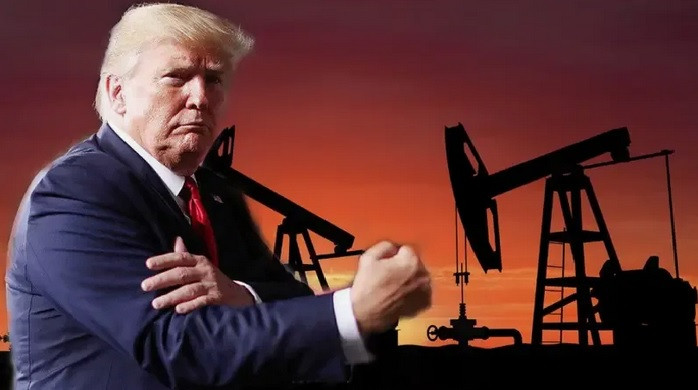
Venezuela possesses some of the largest proven oil reserves in the world, but its production has sharply declined in recent years due to sanctions and low investment. For the U.S., control over the political transition opens the possibility of restarting production under the management of or with the participation of American oil companies, which Trump explicitly stated when speaking about granting major American oil companies access to Venezuelan fields.
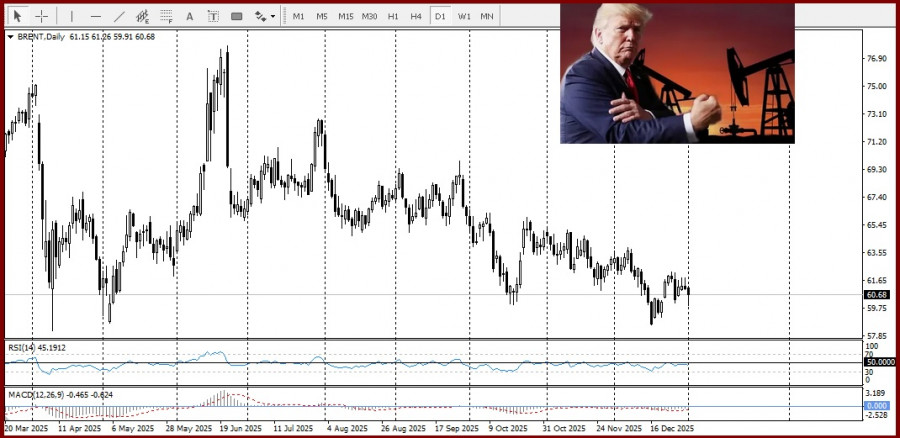
Maintaining a formal embargo while exercising de facto control over the regime can be used as a tool for selective access to Venezuelan oil for Washington and for pressure on competitors, including Russia and Iran, in the struggle for market share in heavy crude grades. In the medium term, the lifting of restrictions and the restoration of Venezuelan production could increase global supply and put downward pressure on oil prices, provided there is no simultaneous significant reduction in supplies from other regions.
Strengthening U.S. control over the flow of Venezuelan oil and its settlements typically implies consolidation of the dollar's role as the key settlement currency in commodity trade, especially if Washington ties the lifting of some sanctions to the use of American financial infrastructure. This increases demand for the dollar through a rise in dollar-denominated settlements and the servicing of debt and investment operations associated with restructuring Venezuela's oil sector.

On the other hand, a military operation and the rise in geopolitical risk typically increase the attractiveness of safe-haven assets, which markets often include the dollar and U.S. Treasuries, supporting the American currency in the short term. For countries dependent on oil imports, the combination of a geopolitical premium in energy prices and a stronger dollar creates pro?inflationary pressure and increases the costs of servicing external debt denominated in U.S. currency.
A potential shift of Venezuela from the camp of U.S. opponents into a zone of direct U.S. influence reduces the risk of dedollarization of the country's oil flows and limits room for alternative settlement schemes involving China or Russia. In the long term, this reinforces the "petrodollar" architecture, where control over key exporters and transport infrastructure supports global demand for the dollar as a reserve and settlement asset.
However, the scale of military escalation and its perception as a precedent for resolving resource conflicts by force may prompt some states — both importers and exporters — to accelerate reserve diversification and seek alternatives to the dollar, creating a dual effect: tactical strengthening of the dollar's position alongside a strategic increase in motivation for gradual diversification.
The material has been provided by InstaForex Company - www.instaforex.com.Trump in the U.S. speaks of the capture of Venezuelan President Maduro. Part 1
.
U.S. President Donald Trump at a press conference at the Mar-a-Lago residence confirmed the conduct of a large-scale military operation against Venezuela and the arrest of President Nicolas Maduro together with his wife Cilia Flores, who, he said, will be taken to New York to face charges of narcoterrorism and related crimes in the Southern District of New York in the form of a conspiracy to possess machine guns and explosive devices against the United States. Against the backdrop of strikes on Caracas's military infrastructure and command centers, Washington announced its intention to temporarily oversee a transitional period of power in Venezuela, while simultaneously declaring the continuation of the oil embargo and prioritizing the interests of American energy companies.
According to open sources, strikes on targets in Caracas and several Venezuelan states were carried out at night, which led to widespread power outages and the disabling of a significant portion of the military infrastructure. The American side characterizes this action as one of the most effective demonstrations of military power and refers to joint actions by U.S. armed forces and law enforcement in the detention of Maduro.
Trump publicly emphasized that Maduro and Cilia Flores "will stand before American justice" and that the U.S. will "run Venezuela" until the completion of a "safe and fair transition period," which in effect amounts to an announcement of an external protectorate during the change of power. At the same time, he declared readiness for a second wave of strikes if necessary, signaling Washington's preparedness for further escalation in the region.
U.S. Attorney General Pamela Bondi reported that Maduro and Cilia Flores have been formally charged in the Southern District of New York, including conspiracy to commit narcoterrorism, smuggling cocaine into the U.S., and unlawful trafficking of heavy weaponry and explosive devices against the United States. These charges rely on an existing line of U.S. policy begun in 2020, when similar narcotics-trafficking and terrorist allegations were brought against Nicolas Maduro, and a reward was announced for information leading to his arrest.
The Venezuelan government issued a harsh official statement, characterizing U.S. actions as "gross military aggression" against a sovereign state and the population in Caracas and several key states. Caracas points to a clear violation of the UN Charter, in particular the principles of sovereignty, equality of states, and the prohibition on the use of force, and warns of a threat to international peace and security in Latin America and the Caribbean.
The Venezuelan side interprets the strikes as an attempt to seize control of the country's strategic resources by force, primarily oil and mineral wealth, and to break its political independence. According to authorities, President Nicolas Maduro ordered a review of all national defense plans, indicating a move toward a long-term confrontational agenda in relations with Washington.
The material has been provided by InstaForex Company - www.instaforex.com.How will Europe counter a strong euro?
.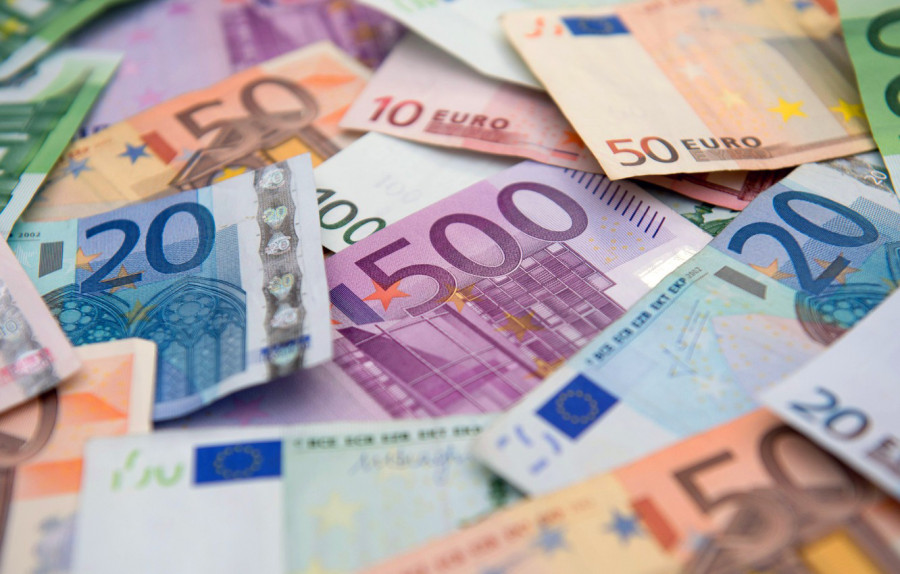
The new year had barely begun when Donald Trump declared war on Venezuela, and the American military delivered a crushing blow on Caracas and other cities. I am not sure the dollar will fall on Monday, but the likelihood of such a scenario is very high. As a consequence, other currencies will appreciate. In particular, the euro.
The problem of a strong/weak exchange rate is not new. Trump has good reason to want to weaken the dollar, because this can increase U.S. export volumes. It's simple — the weaker the U.S. dollar, the cheaper it is for other countries to buy American goods and raw materials. Therefore, virtually all export?oriented countries are interested in weakening their own currency.
There are various ways to weaken a currency. Imagine the central bank, like a madman, starts printing banknotes; more enter circulation, inflation rises, and as a result, the currency depreciates. This method of influencing the currency is called a "currency intervention," and it is tacitly prohibited, since other central banks could carry out retaliatory currency interventions, which would nullify all central banks' efforts. Not all currencies can depreciate simultaneously.
The only apparent way out of this situation is further monetary easing. A loose or "dovish" policy makes investments in EU bank deposits and securities unprofitable compared with similar instruments elsewhere. As a result, demand for the euro falls while demand for other currencies rises. Capital begins to flow from countries with low rates to countries with tighter monetary policy. But will the European Central Bank take such a step?
If rates are cut further, inflation may begin to accelerate. And the ECB spent several years bringing it back to the 2% target. The dilemma is no easy one, but a strong euro will inevitably strike the European economy. Germany's economy — the locomotive of the Eurozone — has long been creaking at the seams. At the same time, Trump's policies may continue to make investors reluctant to deal with the U.S. dollar. It seems that in 2026, alongside military conflicts and trade wars, a currency confrontation may also emerge.
Wave picture for EUR/USD:
Based on the analysis of EUR/USD, I conclude that the instrument continues to build an upward section of the trend. Trump's policies and the Fed's monetary policy remain significant factors in the long-term decline of the US currency. Targets for the current trend section may extend up to the 25-figure level. The current upward wave set may not be complete, but three waves have been built. If it develops further, one should expect growth with targets around 1.1825 and 1.1926, which correspond to 200.0% and 261.8% Fibonacci. But in the near term, a corrective wave or a set of waves may be forming.
Wave picture for GBP/USD:
The wave picture of GBP/USD has changed. The downward corrective structure a-b-c-d-e in C of 4 appears complete, as does the entire wave 4. If this is indeed the case, I expect the main trend section to resume its construction with initial targets around the 38 and 40 figures.
In the short term, I expected the formation of wave 3 or c, with targets around 1.3280 and 1.3360, which correspond to the 76.4% and 61.8% Fibonacci levels. These targets have been reached. Wave 3 or C has presumably completed its construction, so in the near term, a downward wave or a set of waves may be observed.
Main principles of my analysis:
- Wave structures should be simple and understandable. Complex structures are difficult to trade and often change.
- If there is no confidence in what is happening in the market, it is better not to enter it.
- There is never and can never be 100% confidence in the direction of movement. Do not forget protective Stop Loss orders.
- Wave analysis can be combined with other types of analysis and trading strategies.
What does Trump want to achieve in Venezuela?
.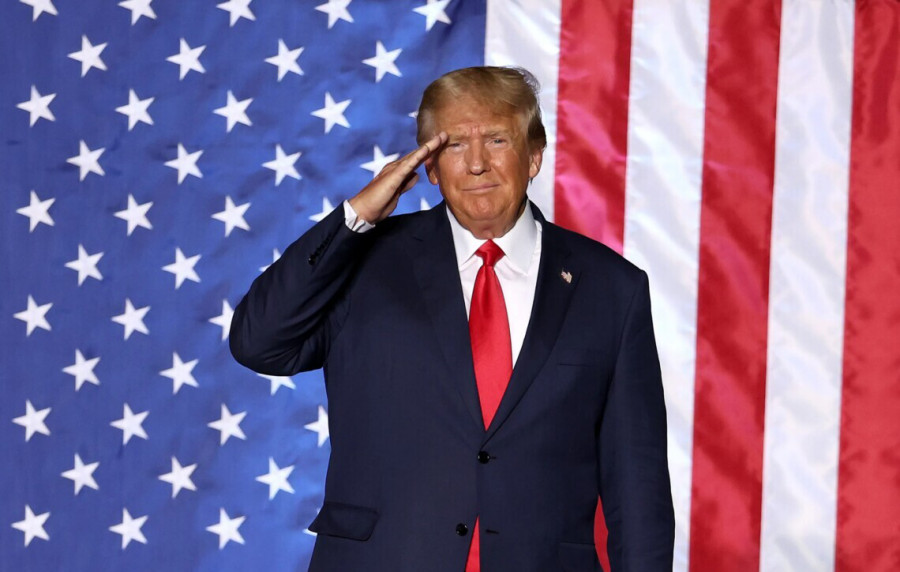
The official version sounds like this. Venezuela remains one of the world leaders in the production and distribution of narcotics; the current Caracas regime facilitates this, and the majority of the drugs end up in the United States — a situation Donald Trump intends to put an end to. However, every coin has a reverse side.
Venezuelan President Nicolas Maduro stated that America is stoking a war in the region and demanded to sit down at the negotiating table. It is hard for me to imagine that Trump will begin negotiations with the Maduro regime, since in recent months, he has repeatedly demanded Maduro's resignation and a change of power in the country. Therefore, the White House leader has outlined his scenario for this conflict and is not prepared to negotiate with terrorists (in his view).
Maduro insists that the problem lies not in the distribution of drugs across US territory but in America imposing its will — something America "sins" by rather often under Trump. Maduro rejected any accusations that he is the leader of a terrorist organization distributing banned substances and said that Washington's true goal is to establish control over Venezuelan oil, natural resources, and gold.
Maduro also said his country is ready for negotiations both on drug trafficking and on investments in the Venezuelan oil industry (if America wants to enter that market). However, Trump's policy is known worldwide. It is ultimatums that must be complied with; otherwise, sanctions, tariffs, blockades, or (as in Venezuela's case) a military operation and air strikes will follow.
Based on the above, it is evident that Maduro wants to retain power in the country and negotiate with Washington. At the same time, Trump sees no reason to negotiate with the "head of a drug cartel" and demands Maduro's immediate departure from the presidency. The conflict may end very quickly if Maduro accepts Trump's demands, or it may drag on for many years.
Based on all of the above, I believe the dollar will be under pressure next week, regardless of US economic data, which may only create additional problems for the American currency. The dollar continues to be fired upon from all sides. In 2025, this was the trade war, Trump's pressure on the Federal Reserve, the FOMC's "dovish" monetary policy prospects, and uncertainty related to Donald Trump's policies. In 2026, this may be US military conflicts, a new escalation of the trade war, and Fed rate cuts.
Wave picture for EUR/USD:
Based on the analysis of EUR/USD, I conclude that the instrument continues to build an upward section of the trend. Trump's policies and the Fed's monetary policy remain significant factors in the long-term decline of the US currency. Targets for the current trend section may extend up to the 25-figure level. The current upward wave set may not be complete, but three waves have been built. If it develops further, one should expect growth with targets around 1.1825 and 1.1926, which correspond to 200.0% and 261.8% Fibonacci. But in the near term, a corrective wave or a set of waves may be forming.
Wave picture for GBP/USD:
The wave picture of GBP/USD has changed. The downward corrective structure a-b-c-d-e in C of 4 appears complete, as does the entire wave 4. If this is indeed the case, I expect the main trend section to resume its construction with initial targets around the 38 and 40 figures.
In the short term, I expected the formation of wave 3 or c, with targets around 1.3280 and 1.3360, which correspond to the 76.4% and 61.8% Fibonacci levels. These targets have been reached. Wave 3 or C has presumably completed its construction, so in the near term, a downward wave or a set of waves may be observed.
Main principles of my analysis:
- Wave structures should be simple and understandable. Complex structures are difficult to trade and often change.
- If there is no confidence in what is happening in the market, it is better not to enter it.
- There is never and can never be 100% confidence in the direction of movement. Do not forget protective Stop Loss orders.
- Wave analysis can be combined with other types of analysis and trading strategies.
USD/CHF. Analysis and Forecast
.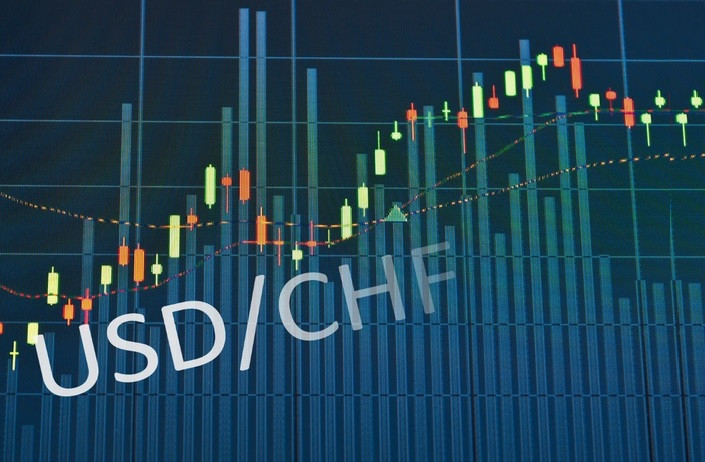
Today, the USD/CHF pair came under pressure during the U.S. session. In recent months, the U.S. dollar has faced significant pressure amid market concerns related to Trump's trade policy, signs of an economic slowdown, and high inflation in the country. Unprecedented critical statements by President Donald Trump toward the Federal Reserve have also weighed on the dollar. Expectations of further easing in Fed monetary policy are limiting dollar strength.
The U.S. central bank cut rates by 25 basis points at its last two monetary policy meetings and is projecting two more cuts in 2026. In addition, Chairman Jerome Powell's term expires in May, and Trump is likely to appoint a more dovish policymaker to the position, with a decision on the candidate expected to be announced in the coming weeks. These circumstances reinforce expectations of a more aggressive monetary easing cycle.
Nevertheless, the latest U.S. macroeconomic indicators look fairly optimistic. For the first time in a long while, initial jobless claims fell by 16 thousand to 199 thousand in the week ending December 26, beating the revised figure from the previous week (215 thousand). An increase in real estate transactions has also been noted — the highest level in the past three years. Today's release of the U.S. manufacturing activity index (S&P Global Manufacturing PMI) confirmed a moderate slowdown in the sector. However, investors are awaiting the key December nonfarm payrolls report, the release of which has been postponed to next week, as it will provide a clearer picture of expectations regarding the Fed's interest rate path.
In Switzerland, the KOF Economic Barometer showed a surprising improvement, rising to 103.4 in December from 101.7 in the previous month — the highest reading in more than a year. This points to a potential strengthening of economic growth ahead. Despite the positive assessment, the KOF institute noted strong readings in the industrial and construction sectors, while also warning of signs of weakening in demand indicators.
From a technical perspective, oscillators on the daily chart are in negative territory. The 9-day EMA is below the 14-day EMA, which also confirms a bearish outlook for the USD/CHF pair. Resistance is located at the 14-day EMA around 0.7933, above which the next resistance lies at 0.7943. Solid support has been found at the round 0.7900 level.
The material has been provided by InstaForex Company - www.instaforex.com.The market does not believe in a new easing in January
.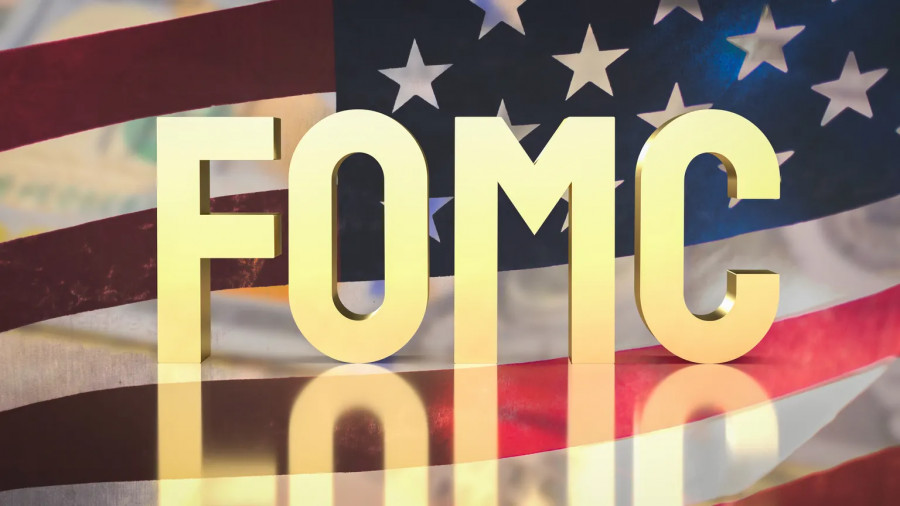
Pressure on the U.S. currency remains, and the market continues to expect very active measures from the Federal Reserve in 2026. At the very least, the current state of the U.S. labor market suggests that these expectations are not unfounded. The latest reports for November showed that the labor market may have stopped "cooling," but this is a highly debatable claim. Let me remind you that the Nonfarm Payrolls report is quite specific, and not all traders interpret it correctly.
It should be understood that the number of newly created jobs is not equal to the net increase in employment in the economy. Every month, hundreds of thousands of Americans lose their jobs, quit, companies close and open, new employees are hired, and so on. Nonfarm Payrolls only signals newly created jobs and does not take into account the number of layoffs and job losses. Consequently, even a high payrolls reading does not mean that the total number of workers in the U.S. has increased. If, over the same period, layoffs exceeded the number of newly created jobs, this represents a decline rather than a gain in the labor force.
It should also be understood that the Nonfarm Payrolls report does not account for, for example, the self-employed or freelancers. In recent decades, an entire profession of "blogger" has emerged, and it is obvious that all these people earn money but are not officially employed anywhere. The report does not take them into account. It also does not include self-employed freelancers who receive orders through relevant platforms and are likewise not counted. Therefore, overall, it can be said that the Nonfarm Payrolls report is not the most accurate measure of the labor market's condition, and its figures should be interpreted correctly.
In November, 60 thousand jobs were created in the United States, and this figure is negative. This is because, over the same period, layoffs were almost certainly far higher than 60 thousand. On average, 100–200 thousand workers lose their jobs in the U.S. every month, so the payrolls figure should be at least 100 thousand just to be considered neutral.
Based on all of the above, I cannot say that the U.S. labor market has begun to recover. The current situation will be clarified by the reports due next week, but the easing of the Fed's monetary policy should continue in 2026. In January, the market does not expect a new round of interest rate cuts, but more definitive conclusions can be drawn next week.
Wave picture for EUR/USD:
Based on the EUR/USD analysis conducted, I conclude that the pair continues to build an upward trend segment. Donald Trump's policies and the Federal Reserve's monetary policy remain significant factors behind the long-term decline of the U.S. dollar. The targets of the current trend segment may extend as far as the 25th level. The current upward wave sequence may not be complete yet, but three waves have already been formed. If it develops further, growth should be expected with targets around 1.1825 and 1.1926, which correspond to the 200.0% and 261.8% Fibonacci levels. However, a corrective wave or a set of corrective waves may form in the near term.
Wave picture for GBP/USD:
The wave picture of the GBP/USD pair has changed. The downward corrective structure a-b-c-d-e within wave C of wave 4 appears complete, as does the entire wave 4. If this is indeed the case, I expect the main trend segment to resume, with initial targets around the 38th and 40th levels.
In the short term, I expected the formation of wave 3 or c with targets around 1.3280 and 1.3360, which correspond to the 76.4% and 61.8% Fibonacci levels. These targets have been reached. Wave 3 or c has presumably completed its formation, so in the near future a downward wave or a set of waves may develop.
Core principles of my analysis:
- Wave structures should be simple and clear. Complex structures are difficult to trade and often signal changes.
- If there is no confidence in what is happening in the market, it is better not to enter it.
- There is no and can never be 100% certainty about the direction of price movement. Do not forget to use protective Stop Loss orders.
- Wave analysis can be combined with other types of an
EUR/USD Analysis on January 2, 2025
.The wave pattern on the 4-hour chart for EUR/USD has been quite clear, albeit rather complex in recent months. There is no talk of canceling the upward trend segment that began in January of last year, but the wave structure starting from July 1, 2025 has taken on a complex and extended form. In my view, the instrument has completed the construction of corrective wave 4, which took on a very non-standard shape. Within this wave, we observed exclusively corrective structures, so there is no doubt about the corrective nature of this wave.
In my opinion, the construction of the upward trend segment has not been completed, and its targets extend as far as the 25th level. The series of waves a-b-c-d-e appears to be complete; therefore, over the coming weeks I expect the formation of a new upward wave sequence. We saw the presumed waves 1 and 2, and the pair is now in the process of forming wave 3 or c, which took on a five-wave structure and, therefore, has been completed. In the coming days, a decline in quotes can be expected, which is exactly what we are currently observing.
The EUR/USD pair declined by 10 basis points on Friday, although intraday movements were quite active. However, they were not active enough to conclude that the holidays were over. Most likely, the market will get back to business on Monday, when the first reports of the year begin to be released. For now, market participants can, with a clear conscience, continue to rest, finish their Olivier salad, and drink the remaining champagne. There is no news background, so I do not link the movements of the New Year week to any events — simply because there are none.
In my view, the pair is currently moving strictly according to waves, which is clearly visible even to beginner traders. Any trader knows that a classic impulsive (trend) structure consists of five waves, while a classic corrective structure consists of three waves. Within the local wave 3 or c, we observed five waves; therefore, a decline should be expected in any case. If the upward wave sequence that began on November 5 is not completed and takes on a five-wave form, then after the correction we will see a new rise in quotes. Personally, I support this scenario. However, there is another one.
The upward wave sequence may be limited to three waves, which would make it another corrective segment — and such segments have, by and large, been alternating for about six months. Of course, much will depend on the news background next week, as next week will be the first working week of 2026, so U.S. reports on unemployment, nonfarm payrolls, wages, and business activity will be released. These reports may trigger reactions from both buyers and sellers, since U.S. economic data still has a strong influence on FOMC monetary policy.
General conclusions
Based on the EUR/USD analysis conducted, I conclude that the pair continues to build an upward trend segment. Donald Trump's policies and the Federal Reserve's monetary policy remain significant factors weighing on the U.S. dollar in the long term. The targets of the current trend segment may extend as far as the 25th level. The current upward wave sequence may not be complete yet, but three waves have already been formed. If it continues to develop, growth should be expected with targets near 1.1825 and 1.1926, which correspond to the 200.0% and 261.8% Fibonacci levels. However, in the near term, a corrective wave or a set of corrective waves may be forming.
On a smaller scale, the entire upward trend segment is visible. The wave count is not the most standard, as corrective waves vary in size. For example, the larger wave 2 is smaller than the internal wave 2 within wave 3. However, this can also happen. Let me remind you that it is best to identify clear and understandable structures on charts, rather than necessarily trying to label every single wave. At the moment, the upward structure raises no doubts.
Core principles of my analysis:
- Wave structures should be simple and clear. Complex structures are difficult to trade and often signal changes.
- If there is no confidence in what is happening in the market, it is better not to enter it.
- There is no and can never be 100% certainty about the direction of price movement. Do not forget to use protective Stop Loss orders.
- Wave analysis can be combined with other types of analysis and trading strategies.
AUD/USD. Analysis and Forecast
.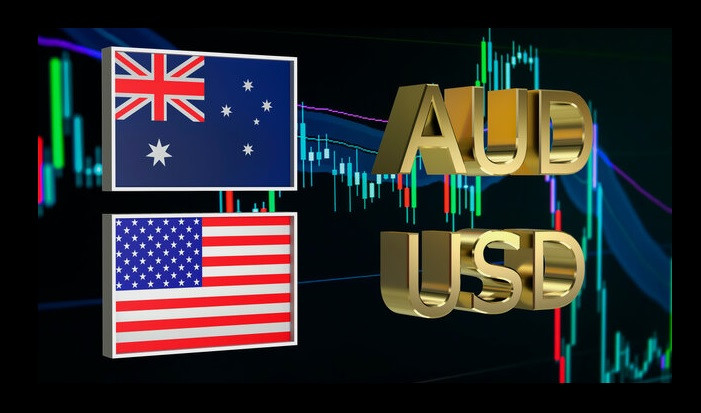
After the Reserve Bank of Australia meeting on December 9, the rhetoric of Governor Michele Bullock became noticeably more hawkish. Both her statements and the published meeting minutes indicate that inflation has once again taken center stage, and the possibility of an additional interest rate hike was actively discussed as early as last month.
Consumer inflation in the country continues to accelerate: in October, the annual rate reached 3.8%, up from 3.6% in September and 3.2% in August. The November report will be released next week. Wage growth data also suggest that price pressures are intensifying. If this trend persists, the likelihood of an RBA rate hike will increase, supporting a strengthening of the Australian dollar.
At the same time, the situation in the United States is developing in the opposite direction. The Federal Reserve remains in the middle of a monetary easing cycle. Recent economic data, including jobless claims statistics, have been fairly positive. Nevertheless, political factors may add uncertainty: President Donald Trump is considering replacing Jerome Powell with a more dovish leader once his term ends in May.
Against the backdrop of New Year holidays in Japan and China, trading activity on Friday remains subdued. Market focus remains on the release of the U.S. manufacturing activity index (S&P Global Manufacturing PMI), the data from which matched expectations.
From a technical perspective, oscillators on the daily chart remain in positive territory, but prices failed to hold above the round 0.6700 level. Support is now provided by the 9-day EMA near 0.6680. If this level fails to hold, prices could accelerate their decline toward 0.6660.
However, if prices manage to break back above the round 0.6700 level, they would be poised to challenge the December high.
The material has been provided by InstaForex Company - www.instaforex.com.GBP/USD. Analysis and Forecast
.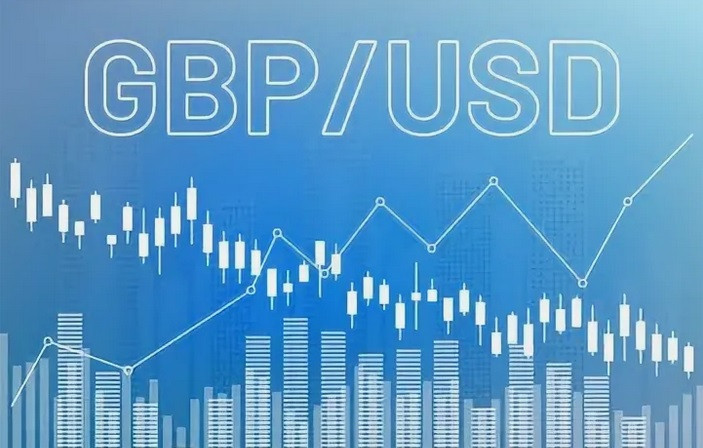
The pound started the European session on Friday by pulling back from the 1.3475 level and, at the time of writing, is trading slightly above 1.3440. Following a downward revision of the UK manufacturing PMI for December (S&P Global), the pound also declined, while remaining within the weekly range and above the 1.3400 threshold.
The manufacturing PMI data published today for the UK showed that growth momentum was weaker than expected. The final reading came in at 50.6 versus the preliminary 51.2. Despite the revision, the indicator remains above the 50.0 level that separates expansion from contraction, as well as above the November reading of 50.2, indicating continued, albeit moderate, expansion in the sector.
Attempts by the U.S. dollar to strengthen remain limited. The short-term trend for the pound remains downward after the December peak above 1.3530; however, the currency is holding on to most of the gains accumulated in November–December, having ended 2025 with an increase of more than 7%.
Over the past year, the dollar has been significantly undermined by U.S. President Donald Trump's inconsistent trade policy, signs of weakening economic growth, and political pressure on the Federal Reserve to accelerate interest rate cuts. In the medium term, exchange rate dynamics are determined by the divergence in monetary policy approaches between the U.S. and the UK.
The Bank of England cut its policy rate in December, a move that appears risky against the backdrop of persistent inflationary pressures and disagreements within the Monetary Policy Committee. This makes further policy easing unlikely. At the same time, the Federal Reserve expects at least two rate cuts in 2026, and if Jerome Powell is replaced by a more dovish chair, the probability of additional easing will increase. All else being equal, this configuration of factors may limit the potential for a recovery in the U.S. dollar in the coming months.
The reduced demand for the dollar is explained by a combination of factors: President Trump's inconsistent trade policy, signs of slowing economic growth, and political pressure on the Federal Reserve to further ease policy. In the medium term, the policy divergence between the Fed and the Bank of England remains the key driver of the pair's dynamics.
From a technical perspective, the pair has held above the 1.3440 level and above the 14-day EMA. The nearest resistance lies at 1.3480. A break above it would open the way toward the round 1.3500 level, on the path to the December high.
If the pair fails to hold above 1.3440, it may fall toward the round 1.3400 level, signaling a loss of bullish momentum. However, as long as oscillators on the daily chart remain in positive territory, the bulls remain in control.
The material has been provided by InstaForex Company - www.instaforex.com.EUR/USD. Smart Money. Bulls Are Walking on Thin Ice
.A week ago, the EUR/USD pair reversed in favor of the U.S. dollar and began a decline toward the most recent "bullish" imbalance 10. However, this imbalance was reached as early as December 29, produced almost no reaction, and the price has now slipped down to imbalance 9. Strictly speaking, it is still too early to sound the alarm. One should remember that the holidays are over, but the market has not yet fully recovered after the celebrations. Even imbalance 10 cannot be considered invalidated, since any imbalance is a three-candle formation that is deemed canceled only after its base is broken — in our case, the low of December 19. Thus, the bulls can still get out of the current situation without serious damage. But to do so, they need to stop celebrating and start trading.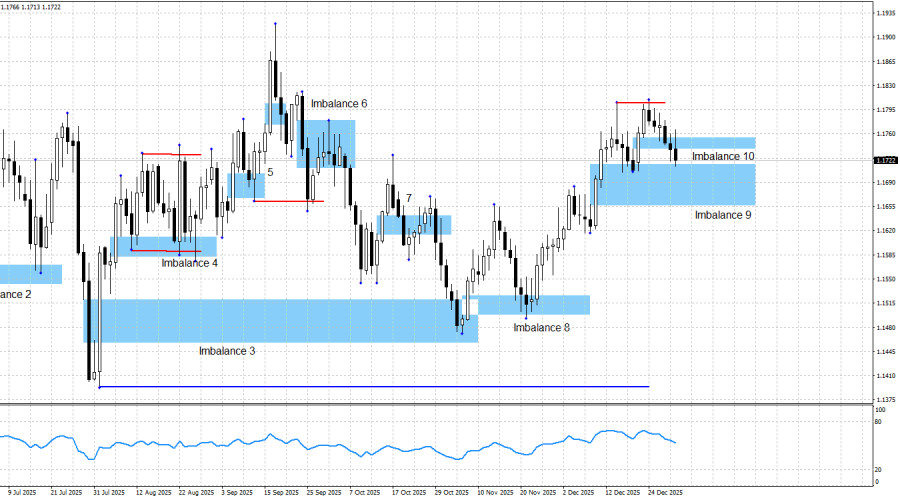
Last week, there was a liquidity sweep from the swing high of December 16, which served as the basis for the start of the decline. The decline itself is still very weak, and a liquidity sweep is not a pattern — one cannot open trades or draw long-term conclusions based on it. The pair's decline may already be completed this week, since bullish imbalances 9 and 10 are support zones for price. The price may get a second reaction at imbalance 9, possibly combined with a liquidity sweep from the swing of December 19.
The chart picture continues to signal bullish dominance. The bullish trend remains intact: a reaction to bullish imbalance 3 has been received, a reaction to bullish imbalance 8 has been received, and a reaction to bullish imbalance 9 has been received. Despite the fairly prolonged decline of the European currency, the dollar has still failed to break the bullish trend. It had five months to do so and achieved no result. If bearish patterns appear or bullish ones are invalidated, the strategy can be adjusted. But at the moment, nothing points to such a scenario.
There was no significant news background on Friday, and trader activity after the New Year remains minimal.
The bulls have had more than enough reasons for a new offensive for the past three months, and all of them remain relevant. These include the (in any case) dovish outlook for FOMC monetary policy, Donald Trump's overall policy (which has not changed recently), the U.S.–China confrontation (where only a temporary truce has been reached), protests against Trump (which have already swept across America three times this year), weakness in the labor market, the bleak outlook for the U.S. economy (recession), and the government shutdown (which lasted a month and a half but was clearly not priced in by traders). Thus, in my view, further growth of the pair would be entirely natural.
One should also not lose sight of Trump's trade war and his pressure on the FOMC. Recently, new tariffs have been introduced rarely, and Trump himself has stopped criticizing the Fed. However, I personally believe this is just another "temporary calm." In recent months, the FOMC has been easing monetary policy, which is why no new wave of criticism from Trump has emerged. But this does not mean these factors no longer create problems for the dollar.
I still do not believe in a bearish trend. The information background remains extremely difficult to interpret in favor of the dollar, which is why I do not even try to do so. The blue line marks the price level below which the bullish trend could be considered finished. To reach it, the bears would need to push the price down by about 400 pips, and I consider this task impossible under the current information background and circumstances. The nearest upside target for the European currency remains the bearish imbalance at 1.1976–1.2092 on the weekly chart, which was formed back in June 2021.
News calendar for the U.S. and the European Union:
- U.S. – ISM Manufacturing PMI (15:00 UTC).
On January 5, the economic calendar contains one important event. The impact of the news background on market sentiment on Monday will be felt in the second half of the day.
EUR/USD forecast and trading advice:
In my view, the pair may be in the final stage of the bullish trend. Despite the fact that the information background remains on the bulls' side, bears have been attacking more frequently in recent months. Still, I do not see any realistic reasons for the start of a bearish trend at this time.
From imbalances 1, 2, 4, and 5, traders had opportunities to buy the euro. In all cases, we saw some degree of growth. Traders also had opportunities to open new trend-following long positions when a reaction to bullish imbalance 3 was received, after the reaction to imbalance 8, and then after the bounce from imbalance 9. This week, a reaction to bullish imbalance 10 may be received. The target for euro growth remains the 1.1976 level. Long positions can be kept open with stop losses moved to breakeven, or managed at traders' discretion.
The material has been provided by InstaForex Company - www.instaforex.com.EUR/USD. Analysis and Forecast
.
Today, Friday, the EUR/USD pair continues to decline from its December high. The weakening of the currency pair is driven by negative data on eurozone manufacturing activity, which has strengthened bearish sentiment toward the euro amid relatively quiet New Year trading conditions. Nevertheless, the EUR/USD rate remains close to the three-month high of 1.1808, reached just before the holidays.
Over the past year, the U.S. dollar has fallen by approximately 14% against the euro amid market concerns about the inconsistency of U.S. policy under Donald Trump, as well as signs of a slowdown in the U.S. economy and differences in monetary policy between the ECB and the Federal Reserve.
The latest final PMI data for Germany and the eurozone — the manufacturing Purchasing Managers' Index — point to a deterioration in the contribution of manufacturing activity to the region's gross domestic product. Today, attention should also be paid to the release of the final U.S. PMI data (S&P), which may bring fresh movement to the dollar's dynamics.
From a technical perspective, the pair has found support at the 20-day SMA, while oscillators on the daily chart remain in positive territory, confirming the bulls' ability to hold their ground. If prices fall below the 20-day SMA, the next support will be found at the round level of 1.1700. Below this level, the bias would shift in favor of the bears. Conversely, if prices manage to break above the 9-day EMA, followed by the 1.1760 level, a successful move through it would accelerate the advance toward the round level of 1.1800.
The table below shows the percentage change of the euro against major currencies today. The most notable strengthening of the euro was recorded against the Japanese yen.

GBP/USD. Smart money
.The GBP/USD pair has returned to the "bullish" imbalance 12, and now both currency pairs (EUR/USD and GBP/USD) should be expected to react to bullish patterns. Thus, despite the decline in the pound's quotes over the past few days, the bullish trend remains intact, and the bulls continue to dominate the market. There is no talk of invalidating imbalance 12 at this stage, and corrective pullbacks can vary in size. I see nothing alarming even if the pound drops back to imbalance 11, sweeps liquidity from the swings of December 9 and December 17, and then starts a new upward move.
Last week, another bullish imbalance 12 was formed, and the price is currently working it off. Therefore, the price may react to it as early as today, and traders may receive a new bullish signal. I would like to note that the "imbalance" pattern usually consists of three candles, but in our case it can be considered to consist of four. Let me remind you that an imbalance is a price "slippage." On the chart, it is clearly visible that it spanned two daily candles, which the price literally flew through to the upside. Above the pound, there are practically no significant resistance zones. Thus, there are no bearish patterns, no reactions to bearish patterns, and no liquidity grabs from bullish swings.
The current chart picture is as follows. The bullish trend in the pound could be considered completed, but the bullish trend in the euro is not. Therefore, the European currency can pull the pound upward for as long as necessary. The bulls have bounced off bullish imbalance 1, bullish imbalance 10, and bullish imbalance 11 twice. A large number of buy signals have been formed. A new support zone has formed below — imbalance 12. Thus, I still expect growth toward the yearly highs, around the 1.3765 level.
There was no significant news background on Friday. At the start of the new year, new chart-based buy signals may emerge, allowing traders to once again open long positions.
In the United States, the overall news backdrop remains such that, in the long term, nothing but a decline in the dollar can be expected. The situation in the U.S. remains quite challenging. The government shutdown lasted a month and a half, and Democrats and Republicans agreed on funding only until the end of January. There has been no U.S. labor market data for a month and a half, and the latest figures can hardly be considered positive for the dollar. The last three FOMC meetings ended with dovish decisions, and the latest labor market data allows for a fourth consecutive easing of monetary policy in January. In my view, the bulls have everything they need to continue a new offensive and return to the yearly highs.
For a bearish trend to form, the dollar would need a strong and stable positive news background, which is difficult to expect under Donald Trump. Moreover, the U.S. president himself does not need an expensive dollar, as the trade balance would remain in deficit in that case. Therefore, I still do not believe in a bearish trend for the pound, despite the fairly strong decline in September and October. Too many risk factors continue to hang like dead weight on the dollar. What would allow the bears to push the pound further down if a bearish trend is supposedly forming now? I cannot answer this question, which is why I do not believe that the process of dollar decline will stop. If new bearish patterns appear, a potential decline in the pound sterling can be reconsidered.
News calendar for the U.S. and the UK:
- U.S. – ISM Manufacturing PMI (15:00 UTC).
On January 5, the economic calendar contains one entry that can be considered important and significant. The impact of the news background on market sentiment on Monday will be felt in the second half of the day.
GBP/USD forecast and trading advice:
The outlook for the pound remains favorable for traders. Three bullish patterns have been worked off, signals have been formed, and traders can continue to hold long positions. I see no informational grounds for a sharp decline in the pound in the near future.
The resumption of the bullish trend could have been expected as early as the imbalance 1 zone. At the moment, the pound has reacted to imbalance 1, imbalance 10, and imbalance 11. As a potential upward target, I am considering the 1.3725 level, although the pound may rise much higher. If bearish patterns form, the trading strategy may need to be revised, but this week it is more likely that another bullish signal will be generated from imbalance 12.
The material has been provided by InstaForex Company - www.instaforex.com.EUR/USD. The pair under bearish control: is it worth entering short positions?
.The euro–dollar pair continues to trade within the 17th figure, showing contradictory price action inside the 1.1700–1.1800 level. During Thursday's Asian session, the pair surged sharply to 1.1766, reacting to fairly strong PMI growth data from China. However, at the start of the European session the pair reversed and fell just as sharply, updating the intraday low. In just a few hours, EUR/USD buyers lost all the ground they had gained.
That said, to confirm a downward trend, sellers need not only to break the intermediate support level at 1.1720 (the middle line of the Bollinger Bands indicator on the daily chart), but also to overcome the key price barrier at 1.1690 (the upper boundary of the Kumo cloud on the same timeframe). Only after the bears establish themselves below that level can one speak of the first signs of a trend reversal.
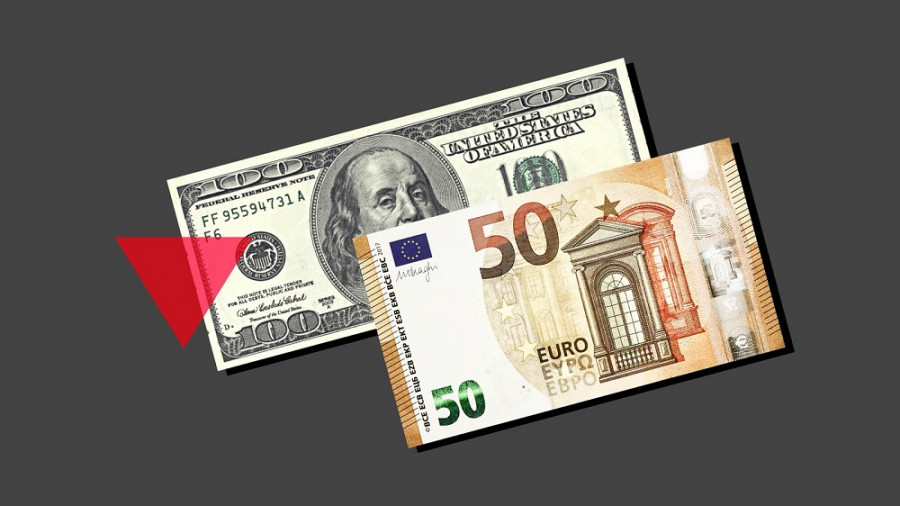
For the third consecutive week, the pair has been trading within the 17th figure, alternately bouncing off the boundaries of the aforementioned price channel. Market participants react impulsively to macroeconomic reports and other fundamental events, but as prices approach the edges of the range they take profits, thereby damping both upward and downward impulses.
Today's EUR/USD price action is a clear illustration of this behavior. Traders responded positively to the PMI reports released in China on the last day of 2025. The data came out in the green zone, which temporarily increased interest in risk assets on the market — including the euro.
Specifically, China's manufacturing PMI rose in December to 50.1, while most analysts had expected a reading of 49.4. First, the index has been rising for a second consecutive month, reflecting positive trends. Second, for the first time since March 2025, the indicator entered expansion territory, surpassing the key 50-point mark. Sub-indices also showed positive dynamics: for example, the production index rose to 51.7 (indicating a significant increase in activity), while the new orders index reached 50.8 (reflecting support for demand). On the other hand, sectoral unevenness remains evident. PMI growth was observed mainly among large companies, while small and medium-sized enterprises continue to face difficulties (especially small businesses). This may reflect easier access for large firms to credit, orders, and government support.
Nevertheless, the fact remains: China's PMI has crossed the critical 50-point threshold for the first time in many months, indicating that the country's manufacturing sector has begun to slow its decline and move into moderate growth.
Positive dynamics were also seen in the non-manufacturing activity index. In December, the indicator rose to 50.2 (versus a forecast of 49.8), after an unexpected drop into contraction territory in November. Notably, the main driver of activity growth was the construction sector — the business activity sub-index in this industry stood at 52.8. The services sector, however, lagged behind: the services business activity sub-index came in at 49.7 in December — still below the key 50.0 mark, though higher than the November reading.
Overall, December PMI data suggest that China's economy has reached a plateau and has begun a cautious recovery. However, it is still too early to talk about full-fledged and sustainable growth — the first months of the current year will be crucial for confirming the trend. The balance will either tilt toward the 50-point territory or slip back into contraction.
This mixed outcome provided only temporary support to EUR/USD buyers. By and large, today is the first full working day of the new year (although it is also the last trading day of the week), so traders are essentially re-evaluating releases that were published before the holidays.
For example, the minutes of the December Federal Reserve meeting turned out to be surprisingly hawkish. First, the document showed that Committee members remain deeply divided over the future course of monetary policy: some believe it is possible to continue easing if inflation keeps slowing, while others favor a pause in order to better assess the effects of steps already taken. Second, some of those who voted for a rate cut stated that the decision was made "on the margin" — under slightly different circumstances, they could have supported keeping rates unchanged.
In other words, the minutes reflected a cautious tone and emphasized the data-dependent nature of the central bank's future actions. After the publication of the minutes, dovish market expectations weakened: the probability of a rate cut at the January FOMC meeting now stands at 14%, and at the March meeting at 46%.
Still, despite the bearish sentiment currently dominating EUR/USD, entering short positions makes sense only if sellers confidently break below the 1.1690 support level (the upper boundary of the Kumo cloud on the daily chart). If the downward impulse fades in this price area, long positions will once again become relevant — with the first (and so far only) target at 1.1760 (the Tenkan-sen line on the daily chart).
The material has been provided by InstaForex Company - www.instaforex.com.EUR/USD Forecast on January 2, 2025
.On Wednesday, the EUR/USD pair declined to the 38.2% corrective level at 1.1718, rebounded, and reversed in favor of the European currency. Thus, the growth process may continue toward the resistance level of 1.1795–1.1802. Today, another rebound from the 1.1718 level would again allow expectations of some growth in the pair, while a consolidation below 1.1718 would increase the likelihood of a decline toward the support level of 1.1645–1.1655 and lead to a breakdown of the "bullish" trend.
The wave situation on the hourly chart remains simple. The last completed upward wave failed to break the peak of the previous wave, while the new downward wave has not yet broken the previous low. Thus, the trend officially remains "bullish." It would be hard to call it strong, but in recent weeks the bulls regained confidence, and then the holidays began. Easing of Fed monetary policy will put pressure on the dollar in 2026, while the ECB will not create any problems for the euro. The "bullish" trend will end if the pair consolidates below the 1.1718 level and the last three lows.
On Wednesday, the news background in the U.S. and the European Union was still absent, and the entire past week and the current week have been more festive than working weeks. Ahead of the New Year, bullish traders stopped attacking and gave bears the opportunity to take the initiative. However, the bears are also in no hurry to attack, preferring to wait until next week, when economic data will start coming in from the U.S. and the EU. I remind you that the key issues for traders remain the U.S. labor market, unemployment, and inflation. For bullish traders to continue their next offensive, these reports must continue to show weak readings. The FOMC has cut interest rates three times, but whether this will be enough to restore the labor market is still unclear. The U.S. dollar still cannot count on strong growth against the European currency, but the bulls also need new reasons to attack. Thus, in my view, it is necessary to wait for the next batch of statistics.
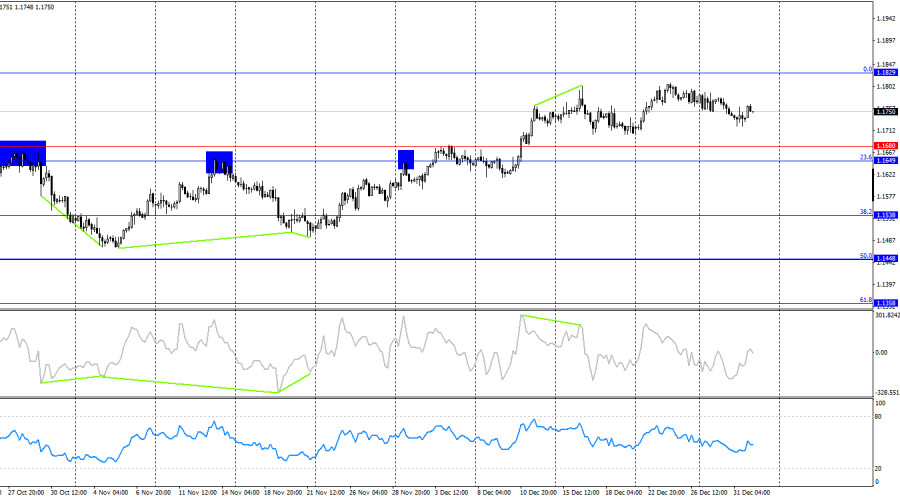
On the 4-hour chart, the pair reversed in favor of the European currency and resumed the growth process toward the 0.0% corrective level at 1.1829. A rebound of quotes from this level would work in favor of the U.S. currency and a moderate decline toward the support level of 1.1649–1.1680. A consolidation above the 1.1829 level would increase the likelihood of further euro growth. No emerging divergences are observed today on any indicator.
Commitments of Traders (COT) Report:
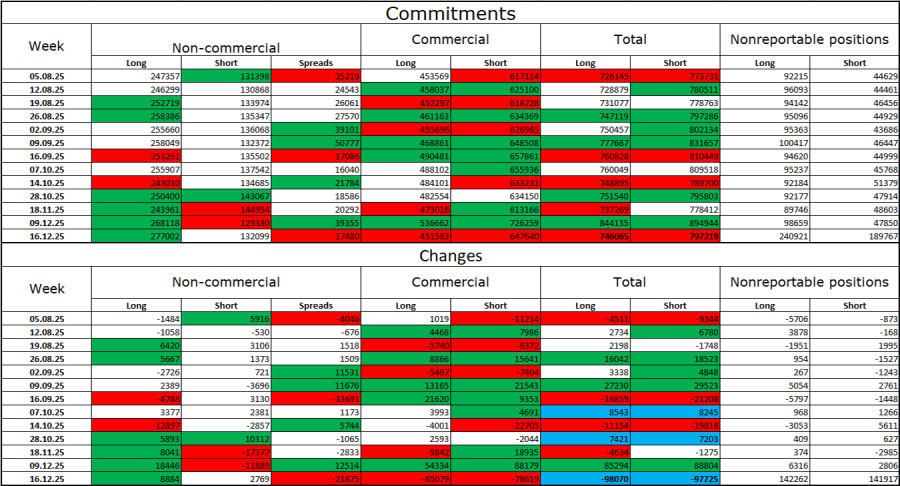
During the last reporting week, professional players opened 8,884 long positions and 2,769 short positions. Sentiment in the "Non-commercial" group remains "bullish" thanks to Donald Trump and his policies, and it is only strengthening over time. The total number of long positions held by speculators now stands at 277 thousand, while short positions amount to 132 thousand. This represents more than a twofold advantage for the bulls.
For thirty-three consecutive weeks, large players were shedding short positions and increasing longs. Then the "shutdown" began, and now we are seeing the same picture again: bulls continue to build up long positions. Donald Trump's policies remain the most significant factor for traders, as they cause numerous problems that will have long-term and structural consequences for the United States. For example, the deterioration of the labor market. Traders fear a loss of the Fed's independence in 2026 under pressure from Trump and against the backdrop of Jerome Powell's resignation in May.
U.S. and Eurozone Economic Calendar:
On January 2, the economic events calendar contains no entries. The influence of the news background on market sentiment on Friday will be absent.
EUR/USD Forecast and Trading Advice:
Selling the pair was possible on a rebound from the 1.1795–1.1802 level on the hourly chart with a target of 1.1718. The target was reached on Friday. A close below the 1.1718 level will allow new sell trades to be opened with a target of 1.1656. Buy trades could be opened on a rebound from the 1.1718 level with a target of 1.1795. Today, these trades can be kept open.
The Fibonacci grids are built from 1.1392–1.1919 on the hourly chart and from 1.1066–1.1829 on the 4-hour chart.
The material has been provided by InstaForex Company - www.instaforex.com.GBP/USD Forecast on January 2, 2025
.On the hourly chart, the GBP/USD pair on Wednesday declined into the support level of 1.3437–1.3470, but so far has formed neither a rebound nor a breakout. Thus, a rebound of quotes from this zone would work in favor of the British pound and a resumption of growth toward the resistance level of 1.3526–1.3539. A consolidation of quotes below the 1.3437–1.3470 level would work in favor of the U.S. dollar and a continuation of the decline toward the support level of 1.3352–1.3362.

The wave situation remains "bullish." The last completed upward wave broke the previous peak, while the new downward wave has so far failed to break the previous low. The news background for the pound has been weak in recent weeks, but the information backdrop in the U.S. also leaves much to be desired. At the beginning of the new year, the bulls retreated slightly, but the trend remains intact, and traders are waiting for economic data.
The news background on Wednesday was essentially absent. However, on December 31, traders were unlikely to expect the release of important reports. Today is a half-holiday, but the market is gradually resuming operations, and by Monday trading may return to its usual rhythm. Already on Wednesday, trader activity began to increase, which indicates the end of the holiday period. Next week, inflation and unemployment reports will be released in the European Union, while in the U.S. there will be Nonfarm Payrolls, unemployment data, and ISM business activity indices. Thus, next week traders will have to determine who will dominate at the beginning of 2026. For the dollar, the key negative factor remains the "dovish" outlook for FOMC monetary policy. However, bullish traders will not attack forever based on this factor alone. New economic data are required to allow for new conclusions.
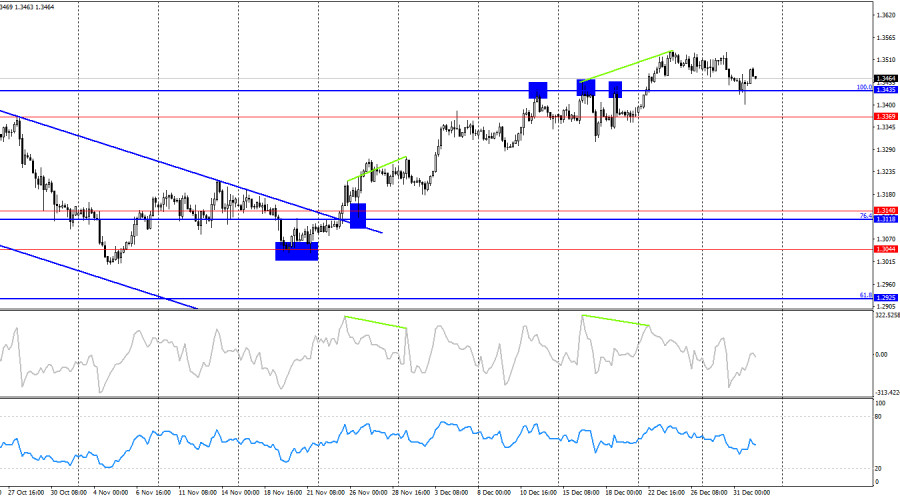
On the 4-hour chart, the pair has consolidated above the 100.0% corrective level at 1.3435, which allows expectations for continued growth toward the next Fibonacci level of 127.2% at 1.3795. A "bearish" divergence has formed on the CCI indicator, which triggered a reversal in favor of the U.S. dollar and a modest decline toward the support level of 1.3369–1.3435. A rebound of quotes from the 1.3435 level would allow expectations of a new rise in the British pound.
Commitments of Traders (COT) Report:

The sentiment of the "Non-commercial" trader category became more "bullish" over the last reporting week. The number of long positions held by speculators increased by 1,649, while the number of short positions decreased by 25,368. The gap between the number of long and short positions is now effectively as follows: 61 thousand versus 110 thousand. As we can see, bears dominated in December, but the British pound seems to have already exhausted its downward potential. At the same time, the situation with contracts on the euro currency is the opposite. I still do not believe in a "bearish" trend for the pound.
In my view, the British pound still looks less "dangerous" than the dollar. In the short term, the U.S. currency may occasionally enjoy demand in the market. But not in the long term. Donald Trump's policies led to a sharp deterioration in the labor market, and the Federal Reserve is forced to ease monetary policy to stop the rise in unemployment and stimulate job creation. For 2026, the FOMC does not plan strong monetary easing, but at the moment no one can be sure that the Fed's stance will not shift to a more "dovish" one during the year.
U.S. and U.K. Economic Calendar:
On January 2, the economic events calendar contains no entries. The influence of the news background on market sentiment on Friday will be absent.
GBP/USD Forecast and Trading Advice:
Selling the pair was possible on a rebound from the 1.3526–1.3539 zone on the hourly chart with a target of 1.3470. The target was reached. I would not rush into new sales until there is a close below the 1.3437 level. I recommended buying on a rebound from the 1.3437–1.3470 level with a target of 1.3533–1.3539. The target was achieved. New buys are recommended on another rebound from the 1.3437–1.3470 level.
The Fibonacci grids are built from 1.3470–1.3010 on the hourly chart and from 1.3431–1.2104 on the 4-hour chart.
The material has been provided by InstaForex Company - www.instaforex.com.Trading Recommendations for Bitcoin (BTC) on January 2 According to the ICT System
.Bitcoin has been trading in another sideways range for three weeks and shows no intention of leaving it. During the holidays, volatility in the crypto market is minimal, and the market moves purely sideways. On the 4-hour timeframe, Bitcoin remains inside the sideways channel that began forming on December 1. Inside the range, trading opportunities can be sought only near its boundaries. Over the last three weeks, signals were received near the upper boundary — two deviations. When a deviation forms near the lower boundary, an upward move can be expected. However, recall that we are primarily interested in sell signals rather than buy signals, since the trend remains downward. Until Bitcoin exits the sideways channel, all internal patterns are irrelevant.
In a longer-term perspective (daily TF), we see a correction that may already be complete. However, one cannot be 100% certain about this because no sell signals have been received. The price only removed the liquidity for sale, but in the last month, it has traded more sideways than down or up. Thus, in the near term, trading is possible only from the boundaries of the sideways channel on the 4-hour TF.
On the weekly TF, Bitcoin must fall below $75,000 for the uptrend that began in 2022 to be officially considered finished. Only below $75,000 can one confidently state the "bullish" structure is broken. If that happens, the fall of Bitcoin could take several years.
Overall BTC/USD picture on 1D
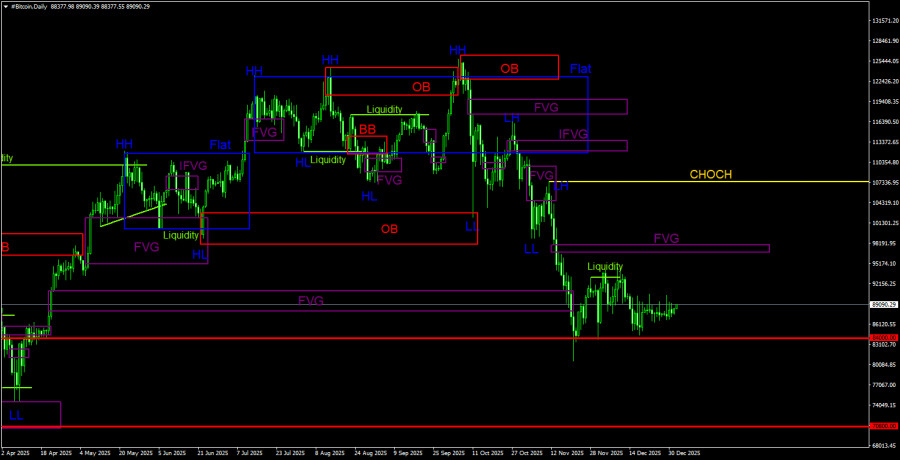
Overall BTC/USD picture on 4H
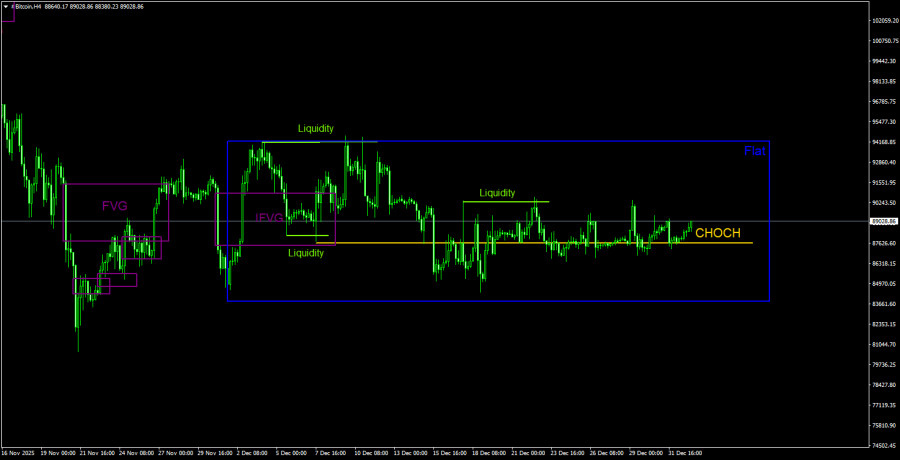
On the 4-hour TF, the technical picture also unambiguously indicates a downward trend, while the price remains in a sideways channel. The CHOCH line (trend break) that ran at $87,600 has been breached, meaning the short-term upward tendency is broken. However, inside the range, local trends do not matter. In the near term, traders can only trade from the boundaries of the sideways channel. From our point of view, sell signals are far more attractive than buy signals. Formally, two sell signals have already been formed. But that signal can already be considered worked out, since more than two weeks have passed since it was formed. On December 18, the price approached the lower line of the channel closely.
Trading recommendations for BTC/USD:
Bitcoin broke the upward structure on the daily TF and, for the first time in three years, began forming a full downward trend. The two nearest targets (the bullish OB in the $98,000–$102,700 area and the bullish FVG) have been worked out; now one should expect a fall to $70,800 (the 50.0% Fibonacci level of the three-year uptrend). Among the POI areas for selling, the only one to highlight is the nearest bearish FVG on the daily TF, located in the $96,800–$98,000 area, which Bitcoin has not yet reached. On the 4-hour TF, one can consider opening positions after new deviations form.
Explanations for illustrations:
CHOCH — change of trend structure (trend break).
Liquidity — liquidity, traders' Stop Losses, which market-makers use to accumulate their positions.
FVG — area of price inefficiency (Fair Value Gap). Price moves through such areas quickly, indicating the absence of one side in the market. Subsequently, the price tends to return and react to these areas.
IFVG — inverted Fair Value Gap. After returning to such an area, the price does not get a reaction but breaks impulsively, then tests it from the other side.
OB — Order Block. The candle is where a market-maker opened a position with the aim of taking liquidity to form their own position in the opposite direction.
The material has been provided by InstaForex Company - www.instaforex.com.Trading Recommendations for Ether (Ethereum) on January 2 According to the ICT System
.Ether continues to trade with minimal price changes, as shown on any timeframe. The lull has lasted for several weeks in a row; the holidays have stretched on. However, this should not leave any traders in a stupor or in disappointment. A flat is an absolutely normal phenomenon. And when else would you expect a flat, if not during the holidays?
The most important thing is that the downside prospects remain. Thus, traders can expect a resumption of the decline. Recall that an excellent sell signal was formed for Ether in the form of the worked-off bearish FVG on the daily timeframe. Traders could open short positions on that signal; those positions are in profit, and there are no signals of a possible reversal upward. Positions can be left open or closed to take profit.
Overall, there is nothing more to add from a technical analysis standpoint. The market is turning down, but the reversal is not technical (the technical reversal happened long ago), but mental and psychological. After Bitcoin failed twice to break its ATHs, many began to understand that the uptrend was coming to an end and, in any case, could not last forever. Of course, many "experts" remain who continue to claim that the current decline is only a correction and that Bitcoin will reach new heights in 2026. That may happen. However, remind traders that many in 2025 also forecast growth to $200,000. Such forecasts should at least be halved.
Analysis ETH/USD 1D

On the daily timeframe, Ether continues to form a downward trend. In recent weeks, the price has been standing still, but earlier another bearish FVG was worked off, which gave a new sell signal. No new patterns have formed recently. The CHOCH line runs at $3,666 — the last Lower High. As long as the price remains below it, the downtrend persists. The upward correction may already be complete, since Ether reached its only unworked bearish FVG and received an unambiguous reaction confirmed on the lower timeframe. But now the market is in a Christmas/New Year pause.
Analysis ETH/USD 4H

On the 4-hour timeframe, the upward corrective trend is broken. The CHOCH line has been breached; therefore, the tendency for Ether is bearish on all timeframes. The last pattern on the 4-hour TF was a worked-off bullish FVG. Five reactions to the bullish FVG led to growth, but each time it was very weak. Recall that Ether's structure is bearish even on the 4-hour TF. Therefore, any rise is a correction. Several liquidity grabs strengthened the buy signal, but it can already be considered worked off.
Recommendations for trading ETH/USD:
A downward trend continues to form on the daily TF. The key sell pattern was and remains the bearish Order Block on the weekly TF. The movement provoked by this signal should be strong and prolonged. The correction in the crypto market may be complete. It is not certain that the trend will resume for Bitcoin/Ether from the bearish daily FVG, but that area was where opening short positions was reasonable. On the 4-hour TF, the cryptocurrency can at any moment begin a new leg down, but there are currently no sell signals or new bearish patterns. Decline targets — $2,717 and $2,618 — remain relevant. And these are only the nearest targets. Ether's downside potential is much greater.
Explanations for illustrations:
CHOCH — break of trend structure.
Liquidity — liquidity, traders' Stop Losses that market-makers use to accumulate their positions.
FVG — Fair Value Gap (area of price inefficiency). Price moves through such areas very quickly, indicating the absence of one side in the market. Subsequently, the price tends to return and react to such areas.
IFVG — Inverted Fair Value Gap. After returning to such an area, the price does not get a reaction but impulsively breaks through it and then tests it from the other side.
OB — Order Block. The candle on which a market-maker opened a position with the aim of taking liquidity to form their own position in the opposite direction.
The material has been provided by InstaForex Company - www.instaforex.com.How to Trade the GBP/USD Currency Pair on January 2? Simple Tips and Trade Review for Beginners
.Trade review for Wednesday:
1H chart of the GBP/USD pair

The GBP/USD pair traded on Wednesday in a manner similar to EUR/USD. Movements were chaotic and mixed, but volatility remained relatively low. The macroeconomic and fundamental backdrop was absent, and the technical picture is currently quite contradictory. We believe the holiday period should not be taken into account, since the market trades somewhat erratically at that time. The overall picture remains unchanged — an upward trend across all timeframes. Therefore, we expect the first macroeconomic data of the new year to arrive next week, at the end of the holidays. The market may begin to move more deliberately as early as Monday, providing clear trading signals and profits. The pound's prospects remain much more attractive than the dollar's.
5M chart of the GBP/USD pair

On the 5-minute timeframe, the pound generated several trade signals on Wednesday. Was it worth trading them on December 31 before the market close? Naturally, the signals were not the best, and volatility has been disappointing for weeks and months. During the holiday week, it became even lower. We believe it is more reasonable to start trading in earnest on Monday, January 5.
How to trade on Friday:
On the hourly timeframe, GBP/USD closed below the trendline, so formally, technical analysis points to a new decline of the pound at the start of the year. However, there are no global reasons for medium-term dollar strength, so we expect movement only to the north. Overall, we also expect the resumption of the 2025 global uptrend for the pair, which could take it to the 1.4000 mark within the next couple of months.
On Friday, beginner traders can consider new long positions if the price rebounds from the 1.3437–1.3446 area, with a target of 1.3529–1.3543. Short positions become relevant if the price closes below the 1.3437–1.3446 area, with a target of 1.3319–1.3331.
On the 5-minute timeframe, you can trade using the levels 1.2913, 1.2980–1.2993, 1.3043, 1.3096–1.3107, 1.3203–1.3212, 1.3259–1.3267, 1.3319–1.3331, 1.3437–1.3446, 1.3529–1.3543, 1.3574–1.3590. No significant events are scheduled in the UK or the US for Friday, and market volatility may remain weak. The market has not fully recovered from the holidays.
Main rules of the trading system:
- Signal strength is judged by the time required for the signal (rebound or breakout) to form. The less time required, the stronger the signal.
- If two or more trades near a level were opened on false signals, then all subsequent signals from that level should be ignored.
- In a flat market, any pair can generate many false signals or none at all. In any case, at the first signs of a flat, it is better to stop trading.
- Trades are opened during the period between the start of the European session and the middle of the American session; after that, all trades must be closed manually.
- On the hourly timeframe, MACD signals should be traded only when there is good volatility and a trend confirmed by a trendline or trend channel.
- If two levels are located too close to each other (5 to 20 pips), they should be considered an area of support or resistance.
- After a 20-pip move in the correct direction, set Stop Loss to breakeven.
What is on the chart:
Support and resistance price levels — levels that serve as targets when opening buys or sells. Take Profit can be placed near them.
Red lines — channels or trendlines that display the current tendency and show the preferred trading direction.
MACD indicator (14,22,3) — histogram and signal line — an auxiliary indicator that can also be used as a source of signals.
Important speeches and reports (always listed in the news calendar) can strongly affect the currency pair's movement. Therefore, during their release, it is recommended to trade as cautiously as possible or exit the market to avoid a sharp reversal of price against the prior move.
Beginner forex traders should remember that not every trade can be profitable. Developing a clear strategy and sound money management are the keys to long-term success in trading.
The material has been provided by InstaForex Company - www.instaforex.com.How to Trade the EUR/USD Pair on January 2? Simple Tips and Trade Review for Beginners
.Trade review for Wednesday:
1H chart of the EUR/USD pair

The EUR/USD currency pair showed nervous, mixed movements on Wednesday, but recall that it was December 31. That says it all. For obvious reasons, there were no macroeconomic or fundamental events that day in either the US or the Eurozone; the market closed in the evening and reopened only last night, then closed again in the evening for the weekend. Essentially, the holidays are over, but the holidays continue. Formally, the price this week breached the ascending trendline, but we do not treat this as a trend change. EUR/USD continues to trade near the upper boundary of the sideways channel on the daily timeframe, between 1.1400 and 1.1830. Very soon (when the market fully "recovers" from the holidays), we expect a new test of this area. Next week, traders will begin receiving macroeconomic data, so moves may become stronger and more attractive.
5M chart of the EUR/USD pair
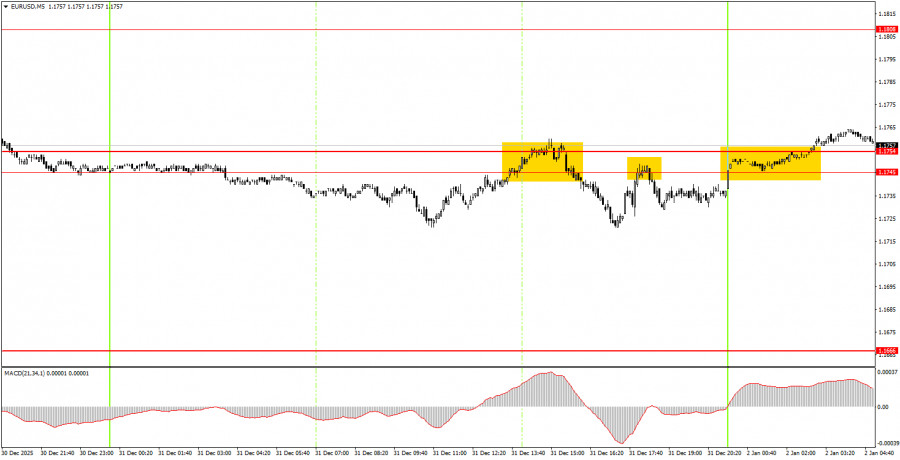
On the 5-minute timeframe, two sell trade signals were formed on Wednesday in the form of two rebounds from the 1.1745–1.1755 area. Beginner traders could have reasonably traded those signals if they had wished to open trades several hours before market close and before the New Year. Last night, the pair broke through the 1.1745–1.1755 area, which is a buy signal. However, moves today may again be very weak, so we do not expect strong euro growth.
How to trade on Friday:
On the hourly timeframe, EUR/USD continues forming an uptrend despite the trendline breach. The price may soon retest the 1.1800–1.1830 area, which is the upper boundary of the daily flat. It is quite possible that this time we will see an exit from the six-month sideways channel. The overall fundamental and macroeconomic backdrop remains very weak for the US dollar; therefore, we expect the pair to rise in the medium term.
On Friday, beginner traders can trade from the 1.1745–1.1754 area. A close above this area allows opening long positions with a target of 1.1808. A close below this area allows opening shorts with a target of 1.1666.
On the 5-minute timeframe, consider the levels 1.1354–1.1363, 1.1413, 1.1455–1.1474, 1.1527–1.1531, 1.1550, 1.1584–1.1591, 1.1655–1.1666, 1.1745–1.1754, 1.1808, 1.1851, 1.1908, 1.1970–1.1988. No important events or releases are scheduled in the EU or the US for Friday. Thus, we may again face very weak moves today.
Main rules of the trading system:
- Signal strength is assessed by the time required for the signal (rebound or breakout) to form. The less time required, the stronger the signal.
- If two or more trades near a level were opened on false signals, then all subsequent signals from that level should be ignored.
- In a flat market, any pair can generate many false signals or none at all. In any case, at the first signs of a flat, it is better to stop trading.
- Trades are opened during the period between the start of the European session and the middle of the American session, after which all trades must be closed manually.
- On the hourly timeframe, MACD signals should be traded only when there is good volatility and a trend confirmed by a trendline or trend channel.
- If two levels are too close to each other (from 5 to 20 pips), they should be considered as an area of support or resistance.
- After the price moves 15 pips in the correct direction, set the stop loss to breakeven.
What is on the charts:
Support and resistance price levels — levels that serve as targets when opening buys or sells. Take Profit levels can be placed near them.
Red lines — channels or trendlines that display the current tendency and show the preferred trading direction.
MACD indicator (14,22,3) — histogram and signal line — an auxiliary indicator that can also be used as a source of signals.
Important speeches and reports (always included in the news calendar) can significantly affect the movement of the currency pair. Therefore, during their release, one should trade as cautiously as possible or exit the market to avoid a sharp reversal of price against the prior move.
Beginner forex traders should remember that not every trade can be profitable. Developing a clear strategy and sound money management are the keys to long-term success in trading.
The material has been provided by InstaForex Company - www.instaforex.com.Trading Recommendations and Trade Review for GBP/USD on January 2. The Pound Rebounded and Is Ready to Rise
.Analysis GBP/USD 5M
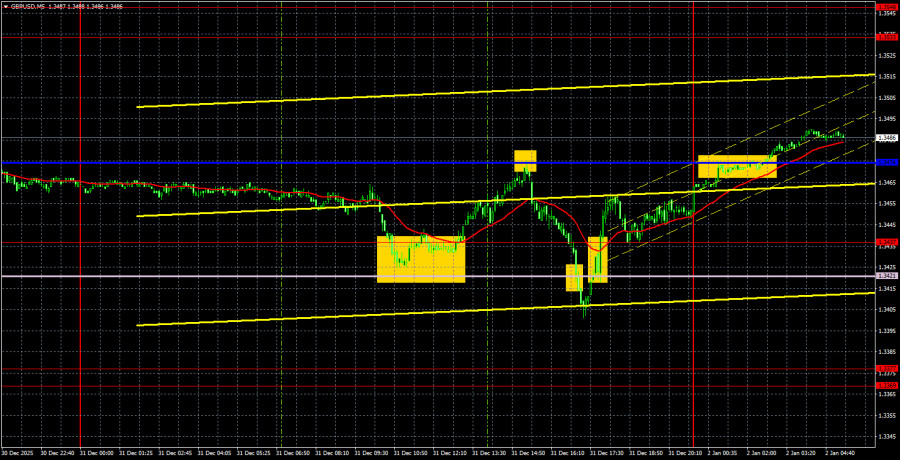
The GBP/USD currency pair formed important signals even on the hourly timeframe on Wednesday. Recall that in the fundamental articles, we spoke about important technical signals for both the euro and the pound on higher timeframes. As we can see, important signals were also formed on the lower timeframes. In particular, the pound rebounded on Friday from the Senkou Span B line, a strong support level for the price. Earlier, the pair broke the ascending trendline, but we believe that a trend change to a downtrend did not occur. At present, the price remains above the Ichimoku indicator lines, so the upward trend persists. This week, there are no major reports or events in either the UK or the US, and the market will resume trading in full on Monday.
In general, the pound continues to "look" upward. Already next week, important US labor market and unemployment data will be published, so the dollar may again come under pressure. However, it was under pressure throughout 2025. In 2026, little is likely to change fundamentally, as global fundamental factors remain the same.
On the 5?minute timeframe on Friday several trade signals were formed, but we do not even see the point in considering them. It is unlikely that anyone opened positions on December 31 in the face of a complete information vacuum.
COT report
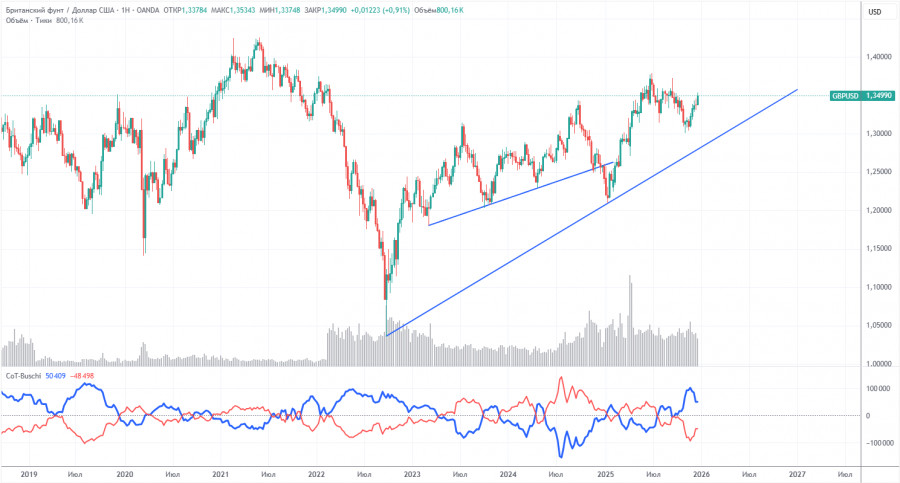
COT reports for the pound show that, in recent years, commercial traders' sentiment has fluctuated. The red and blue lines showing the net positions of commercial and non?commercial traders constantly cross and, in most cases, remain close to zero. At present, the lines are moving apart, but the dominant players are now non?commercial traders with sales. Speculators are increasingly selling the pound, but, as we already said, it does not matter how low the demand for the British currency is. For the US dollar, it is often even lower.
The dollar continues to decline due to Donald Trump's policies, as shown on the weekly timeframe (illustration above). The trade war will continue in one form or another for a long time. The Fed will, in any case, lower rates within the next 12 months. Demand for the dollar will fall one way or another. According to the latest COT report (dated December 16) for the pound, the Non?commercial group opened 1,600 BUY contracts and closed 25,400 SELL contracts. Thus, the net position of non?commercial traders increased by 27,000 contracts over the week.
In 2025, the pound rose significantly, but one should understand that the reason is one: Donald Trump's policy. As soon as this reason is neutralized, the dollar may begin to rise, but nobody knows when.
Analysis GBP/USD 1H
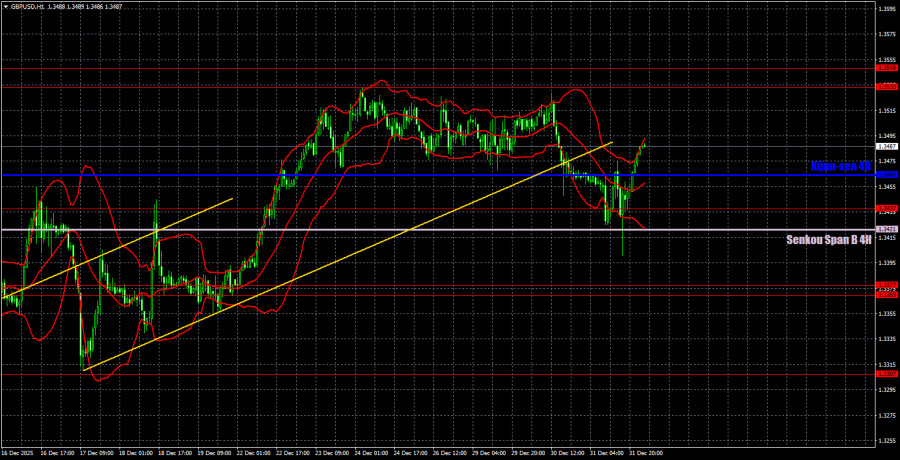
On the hourly timeframe, the GBP/USD pair continues to form an upward trend, but the market is still in a holiday pause. We believe the pound's medium-term rise will continue regardless of the local macroeconomic and fundamental backdrop. The trend for the pound remains upward on virtually all timeframes. Until January 5, we are unlikely to see interesting market moves.
For January 2, we highlight the following important levels: 1.2863, 1.2981–1.2987, 1.3042–1.3050, 1.3096–1.3115, 1.3201–1.3212, 1.3307, 1.3369–1.3377, 1.3437, 1.3533–1.3548, 1.3584. The Senkou Span B (1.3421) and Kijun?sen (1.3464) lines can also be sources of signals. It is recommended to move the stop loss to breakeven when the price moves 20 pips in the correct direction. Ichimoku indicator lines may shift during the day, which should be taken into account when determining trading signals.
No important events or reports are scheduled in the UK or the US on Friday. The pair may trade very weakly, and the possible direction can be determined only by technical factors.
Trading recommendations:
Today, traders can consider selling if the price closes below the critical line, with targets at 1.3437 and Senkou Span B. Long positions are already relevant since the price closed above the Kijun?sen line, with a target of 1.3533–1.3548.
Explanations for illustrations:
- Support and resistance price levels (resistance/support) — thick red lines near which movement may end. They are not sources of trading signals.
- Kijun-sen and Senkou Span B lines — Ichimoku indicator lines transferred to the hourly timeframe from the 4?hour. They are strong lines.
- Extremum levels — thin red lines from which the price previously bounced. They are sources of trading signals.
- Yellow lines — trend lines, trend channels, and any other technical patterns.
- Indicator 1 on the COT charts — the size of the net position of each trader category.
Trading Recommendations and Trade Review for EUR/USD on January 2. Holidays Are Over
.Analysis EUR/USD 5M
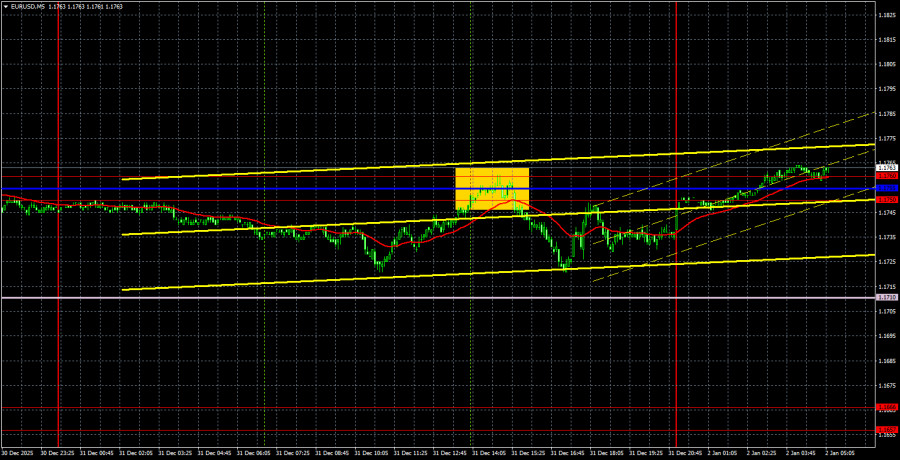
The EUR/USD currency pair traded with minimal volatility on Wednesday, as expected, given it was December 31. It is difficult to even guess who opened trades on December 31, especially in the second half of the day, so the whole day takes on a rather formal, thoroughly holiday feel. Nevertheless, it should be noted that EUR/USD closed on the hourly timeframe below the ascending trendline and below the Ichimoku indicator lines. We believe holiday moves should not be treated too seriously. Today, the price may already close above the Kijun-sen and Senkou Span B lines, indicating the resumption of the uptrend. The macroeconomic and fundamental backdrop was absent, and news will begin to arrive for traders on Monday, January 5.
On the 5-minute timeframe on Friday, one sell trade signal was formed. During the US session, a few hours before market close, the price rebounded from below from the 1.1750–1.1760 area and the Kijun-sen line. After that, the pair moved about 20 pips in the desired direction, which could have been earned if someone opened positions a few hours before the New Year.
COT report
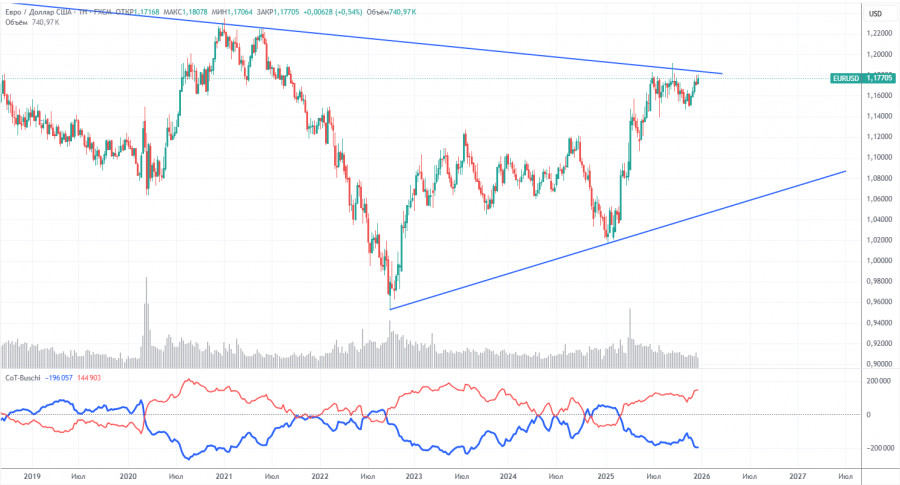
The latest COT report is dated December 16. The illustration above clearly shows that the net position of non?commercial traders was bullish for a long time; bears barely moved into dominance at the end of 2024 but very quickly lost it. Since Trump took office for a second time as US president, only the dollar has been falling. We cannot say that the decline of the US currency will continue with 100% probability, but current world developments point to that scenario. The red and blue lines are diverging, indicating the bulls' strong dominance.
We still do not see any fundamental factors for the strengthening of the euro, while there are plenty of factors for the decline of the US currency. The global downtrend still persists, but what does it matter where the price moved over the past 17 years? Over the last three years, only the European currency has been rising, and that is also a trend.
The placement of the red and blue indicator lines continues to indicate the preservation and strengthening of the bullish tendency. During the last reporting week, the number of longs among the Non?commercial group increased by 8,900, and the number of shorts by 2,700. Accordingly, the net position for the week grew by 6,200 contracts.
Analysis EUR/USD 1H

On the hourly timeframe, EUR/USD remains in an upward trend. The upper line of the sideways channel 1.1400–1.1830 was tested twice, so in the near term, we may observe a technical decline, as the daily timeframe flat remains. However, in the last days of the outgoing year we observed a downward correction, and in the new year bullish pressure may intensify. We expect euro growth to resume despite the breach of the trendline.
For January 2 we highlight the following trading levels — 1.1234, 1.1274, 1.1362, 1.1426, 1.1542, 1.1604–1.1615, 1.1657–1.1666, 1.1750–1.1760, 1.1846–1.1857, 1.1922, 1.1971–1.1988, as well as the Senkou Span B line (1.1755) and the Kijun-sen (1.1762). Ichimoku indicator lines may shift during the day, which should be taken into account when determining trading signals. Do not forget to move the Stop Loss to breakeven if the price has moved 15 pips in the correct direction. This will protect against possible losses if the signal turns out to be false.
No important events or releases are scheduled in the EU or the US for Friday. Movements may again be weak and non?trending during the day.
Trading recommendations:
On Friday, traders can trade from the 1.1750–1.1760 area. A rebound in price from it would make short positions relevant, with a target zone of 1.1657–1.1666. A close above it would allow opening longs with a target of 1.1810–1.1830.
Explanations for illustrations:
- Support and resistance price levels (resistance/support) — thick red lines near which movement may end. They are not sources of trading signals.
- Kijun-sen and Senkou Span B lines — Ichimoku indicator lines transferred to the hourly timeframe from the 4?hour. They are strong lines.
- Extremum levels — thin red lines from which the price previously bounced. They are sources of trading signals.
- Yellow lines — trend lines, trend channels, and any other technical patterns.
- Indicator 1 on the COT charts — the size of the net position of each trader category.
Overview of the GBP/USD Pair. January 2. Double "Bullish" Signal for the Pound
.
The GBP/USD currency pair traded quite actively on Wednesday for New Year's Day. Volatility reached as high as 74 pips, which is, of course, a bit low for the British currency but still significantly higher than for the euro. For most of the day, the pound declined, suggesting a correction was in the offing. But by the end of the day, month, and year, it nevertheless moved back up. Not just "moved back," but "rebounded," which is in itself very important.
In the EUR/USD article, we mentioned an important technical buy signal. For GBP/USD, there were two such signals. The mere fact that buy signals formed on both currency pairs already says a lot. It is no secret that the euro and the pound most often trade in the same direction. Therefore, two identical signals increase the probability that they will work out.
For the pound, the CCI indicator also formed another "bullish" divergence. The seventh or eighth such divergence in recent months, visible even on the 4-hour chart, although this entire period does not even fit on the illustration. Another bullish divergence on an uptrend is a signal of trend continuation. In addition, the CCI entered the oversold area, which is also a buy signal. Thus, on December 31, three buy signals were generated across the euro and the pound in a single day.
This brings us back to the sharp rebound upward on Friday. Such candles are usually reversal patterns and actually indicate liquidity being taken out. Simply put, the price fell to levels where large pending buy orders were placed. The orders triggered — the price shot up. Therefore, we believe that we will already see growth in the pair today, and next week, accompanied by macroeconomic data on the labor market, unemployment, and US business activity, the dollar may well continue to fall.
Recall that, in the medium term, the uptrend remains despite a prolonged, fairly strong correction. The price has crossed the Senkou Span B and Kijun-sen on the daily timeframe, which is another signal of an upward trend. Thus, again, everything indicates that the pound will rise and the dollar will fall.

The average volatility of the GBP/USD pair over the last five trading days is 58 pips. For the pound/dollar, this value is "medium-low." On Friday, January 2, we therefore expect movement inside a range bounded by 1.3396 and 1.3510. The higher linear regression channel has turned upward, indicating trend recovery. The CCI entered oversold territory 6 times in recent months and formed numerous bullish divergences, repeatedly signaling a resumption of the uptrend.
Nearest support levels:
S1 – 1.3428
S2 – 1.3367
S3 – 1.3306
Nearest resistance levels:
R1 – 1.3489
R2 – 1.3550
Trading recommendations:
The GBP/USD pair is attempting to resume the 2025 uptrend, and its long-term prospects have not changed. Donald Trump's policies will continue to put pressure on the dollar, so we do not expect the US currency to appreciate. Thus, long positions with a target of 1.3550 remain relevant for the near term while the price is above the moving average. A price below the moving average allows consideration of small short positions on technical grounds, with targets at 1.3396 and 1.3367. From time to time, the US currency shows corrections (on a global scale), but for the trend to strengthen, it needs signs of an end to the trade war or other global positive factors.
Explanations for illustrations:
- Linear regression channels help determine the current trend. If both are directed the same way, the trend is strong.
- The moving average line (settings 20, 0, smoothed) indicates the short-term trend and the direction in which trading should currently proceed.
- Murrey levels are target levels for moves and corrections.
- Volatility levels (red lines) indicate the likely price channel the pair will trade in over the next 24 hours, based on current volatility indicators.
- The CCI indicator — its move into the oversold area (below -250) or into the overbought area (above +250) indicates that a trend reversal to the opposite direction is imminent.
Test your Forex Trading Knowledge | Forex Quiz Free Online 2026

Think you know something about forex? So, to help you measure just how great your Forex skills are, we have designed a little quiz to test your knowledge. Test your knowledge and skills with our forex trading free online quiz!
Our Forex Quiz contains 10 randomly selected multiple choice questions from a pool containing hundreds of Forex trading and stock market-related topics related questions. Our Forex quiz is absolutely free to use, it’s ad-free and you can use it as often as you like.
Daily Forex and Economic News • Read RSS News Online
Encyclopedia: Forex market analysis
What is fundamental, graphical, technical and wave analysis of the Forex market?
Fundamental analysis of the Forex market is a method of forecasting the exchange value of a company's shares, based on the analysis of financial and production indicators of its activities, as well as economic indicators and development factors of countries in order to predict exchange rates.
Graphical analysis of the Forex market is the interpretation of information on the chart in the form of graphic formations and the identification of repeating patterns in them in order to make a profit using graphical models.
Technical analysis of the Forex market is a forecast of the price of an asset based on its past behavior using technical methods: charts, graphical models, indicators, and others.
Wave analysis of the Forex market is a section of technical analysis that reflects the main principle of market behavior: the price does not move in a straight line, but in waves, that is, first there is a price impulse and then the opposite movement (correction).
Share with friends:
* Frequently asked questions:
What are the risks of Forex trading?
Trading Forex and Leveraged Financial Instruments involves significant risk. As a result of various financial fluctuations (change liquidity, price or high volatility), you may not only significantly increase your capital, but also lose it completely. You should not invest more than you can afford to lose and should ensure that you fully understand the risks involved.

